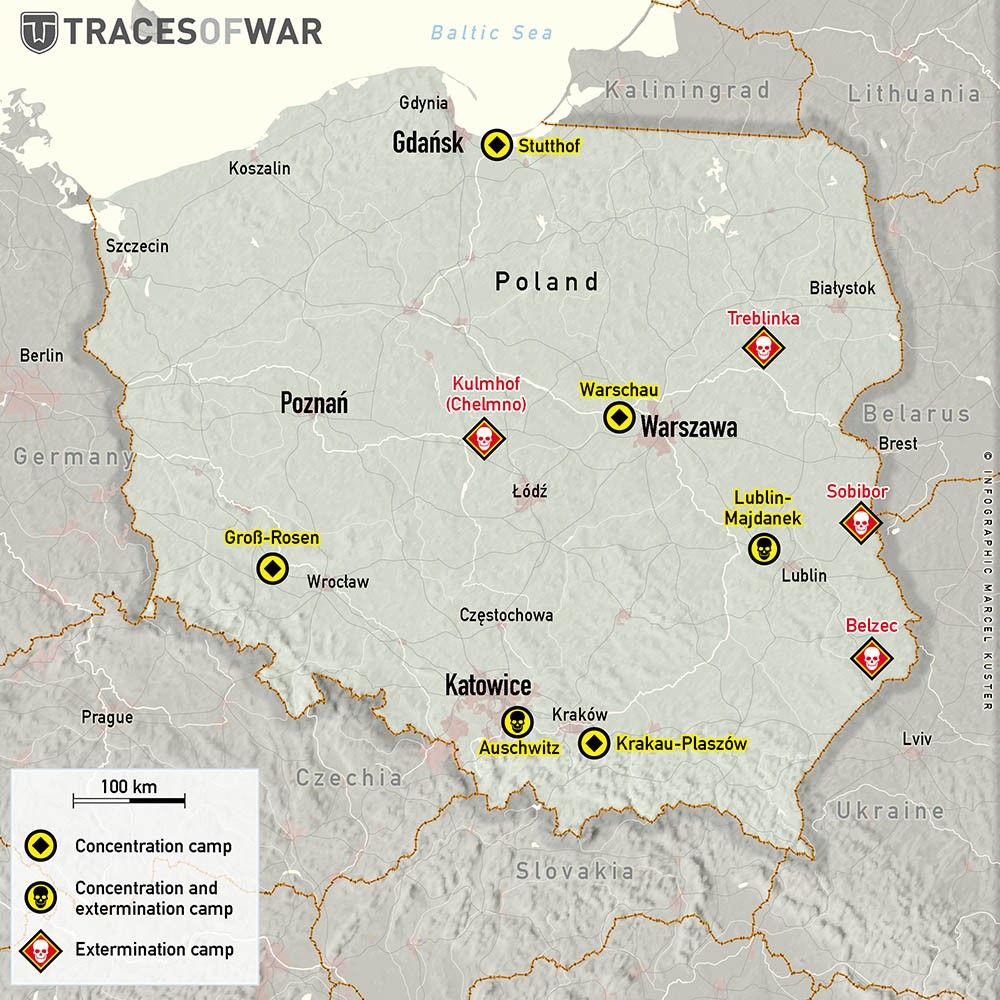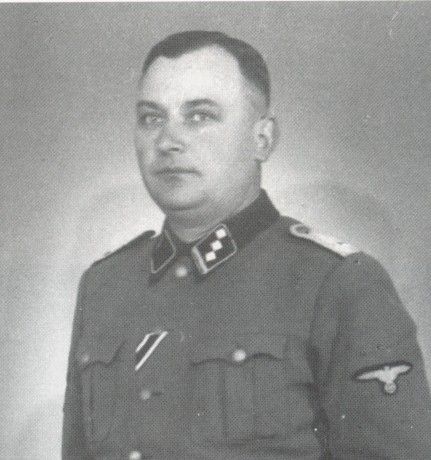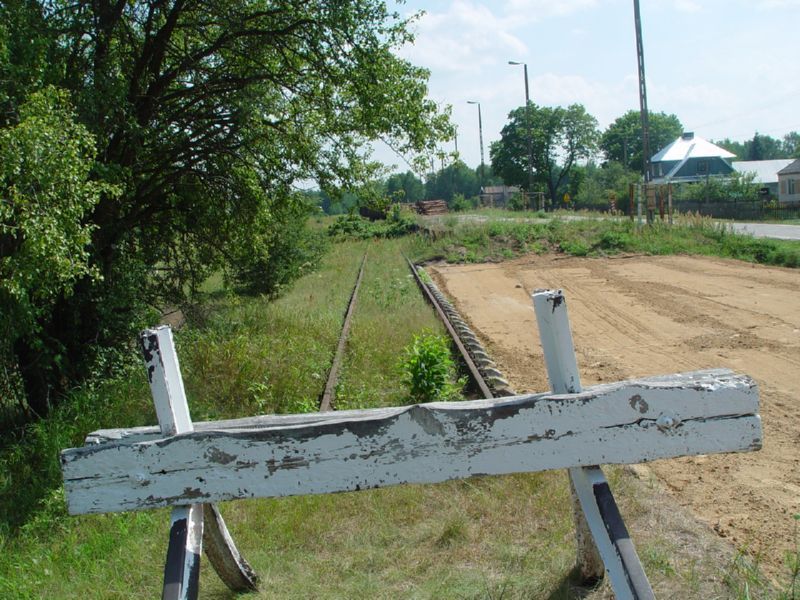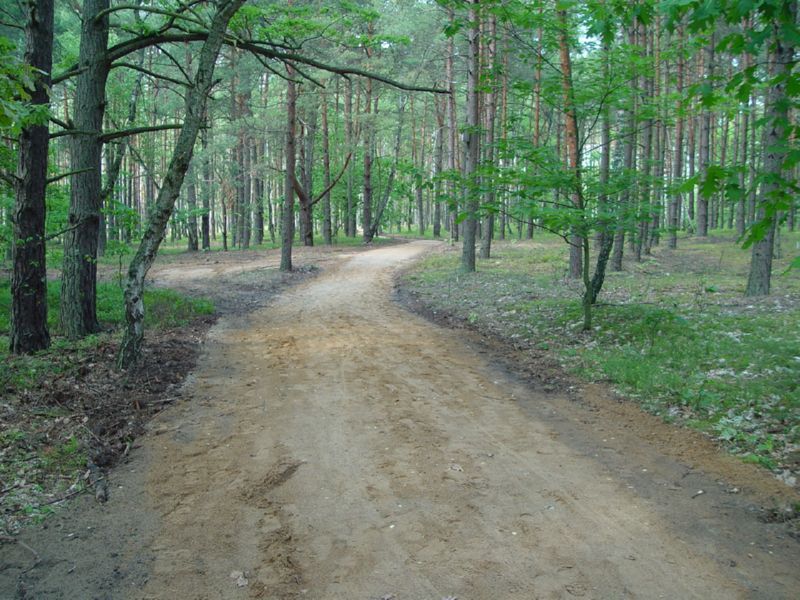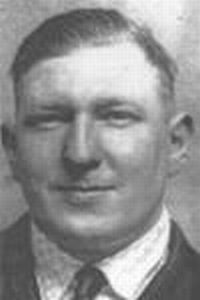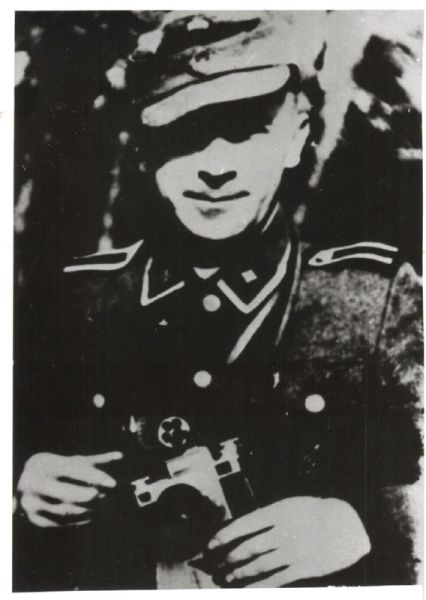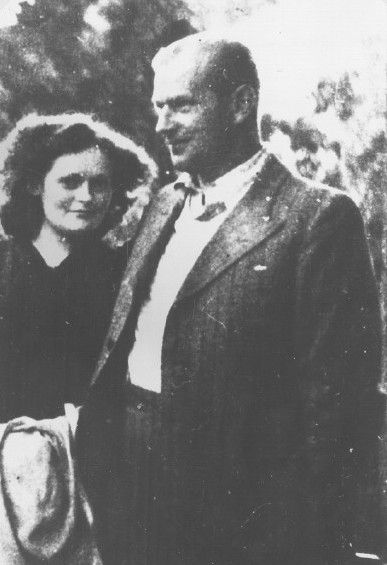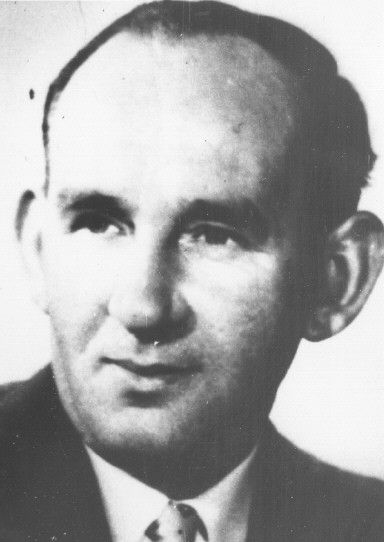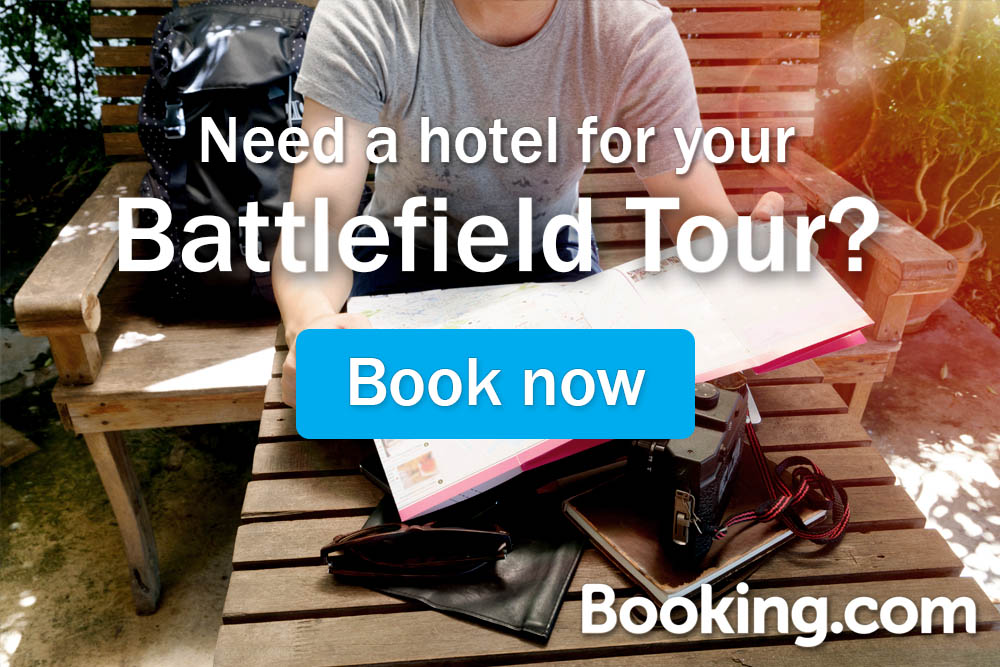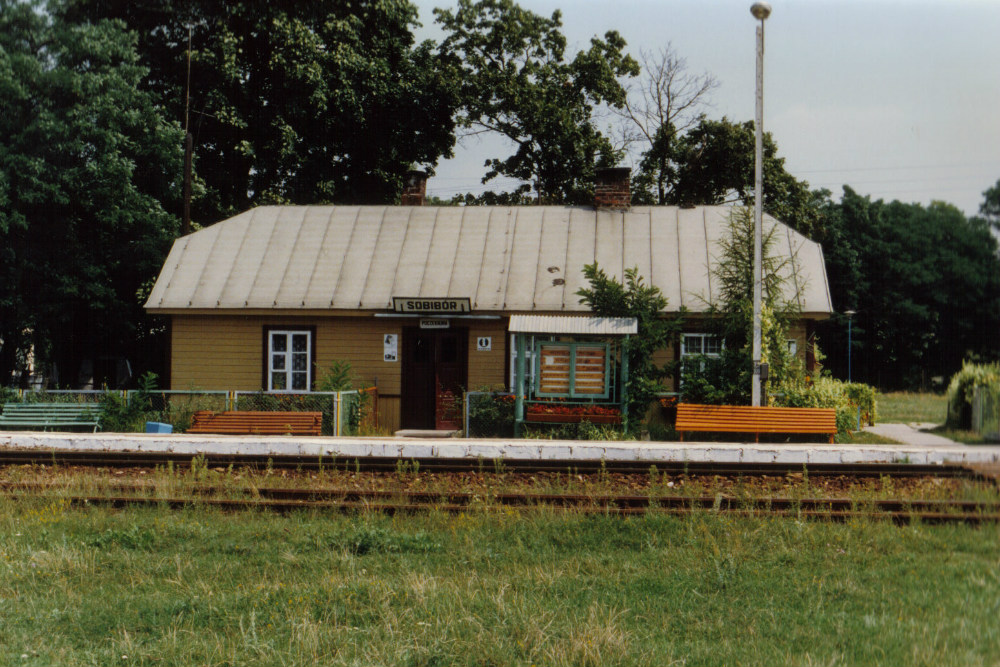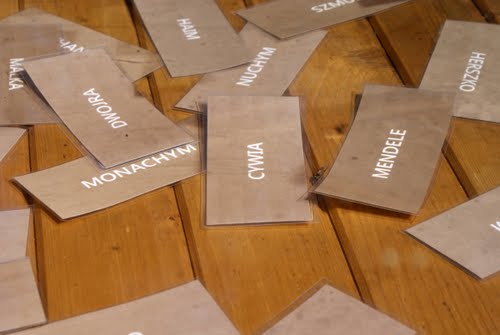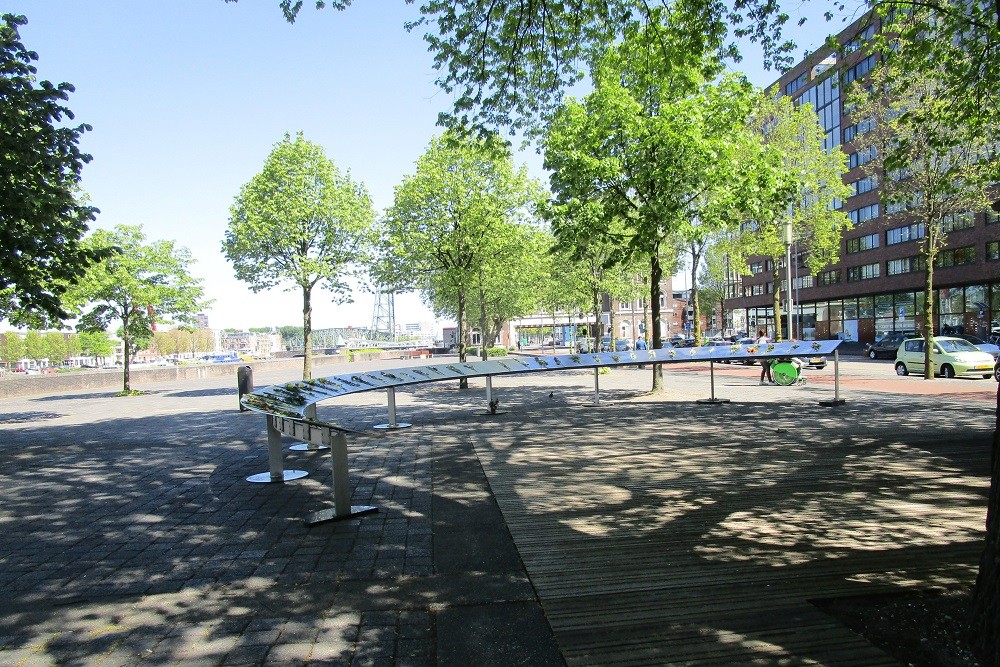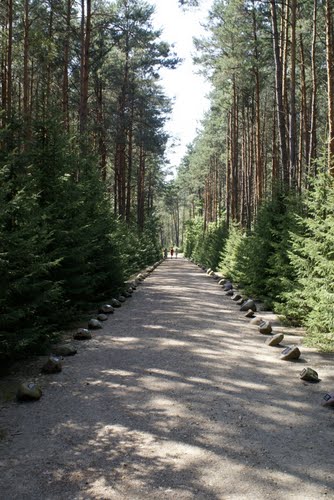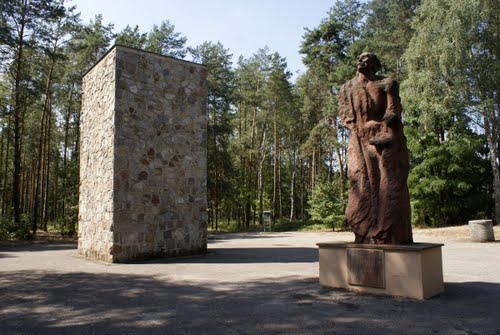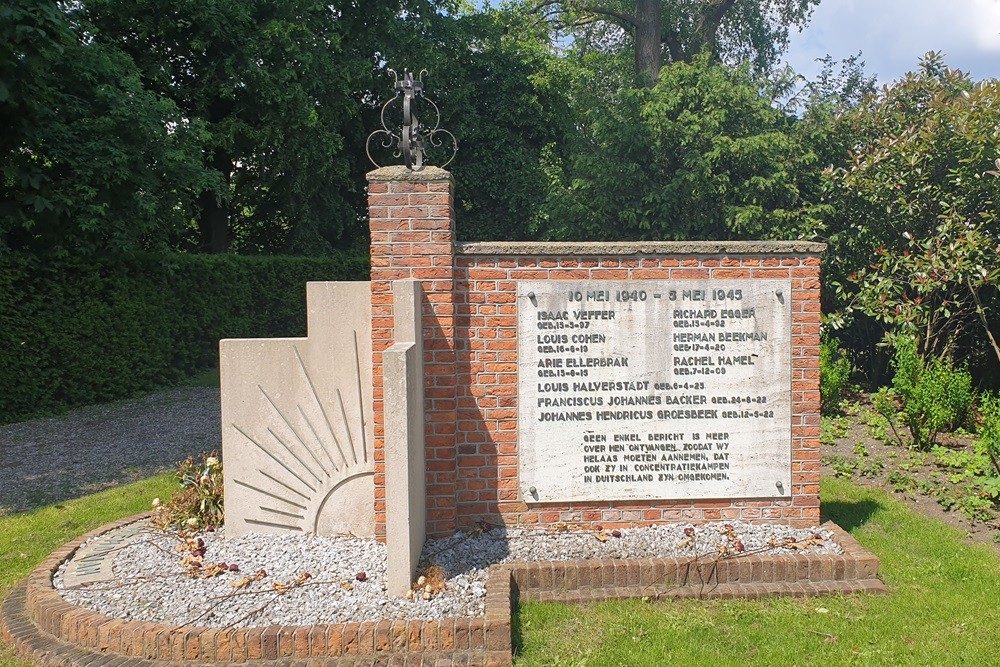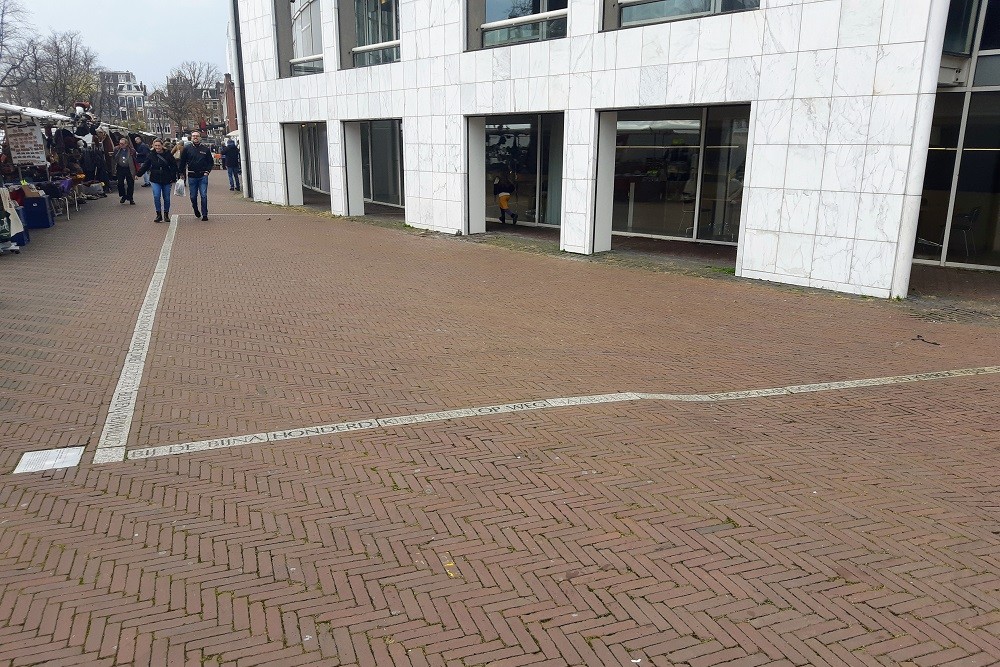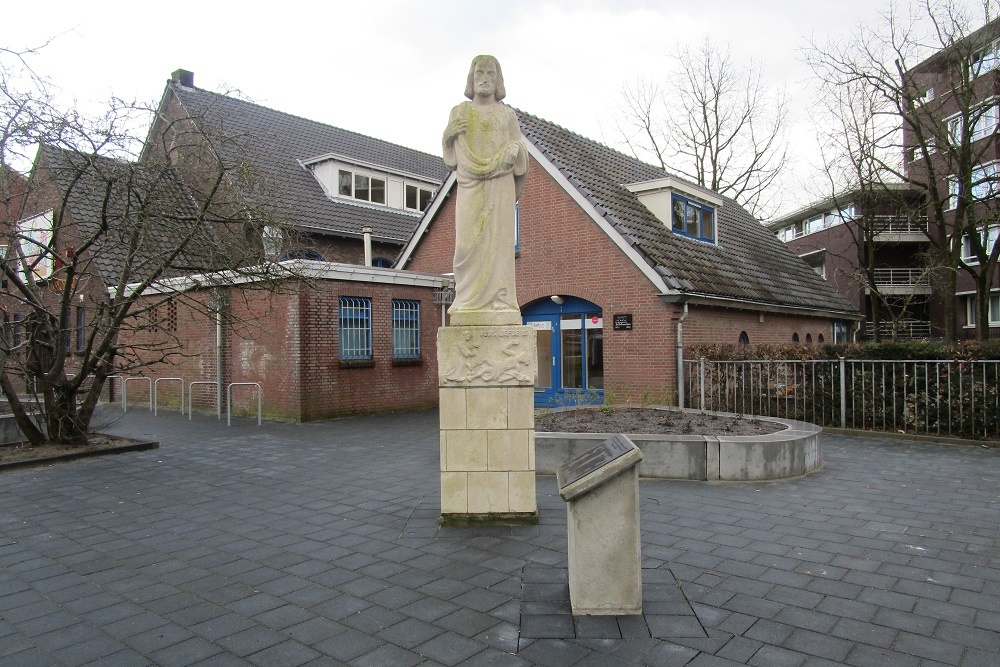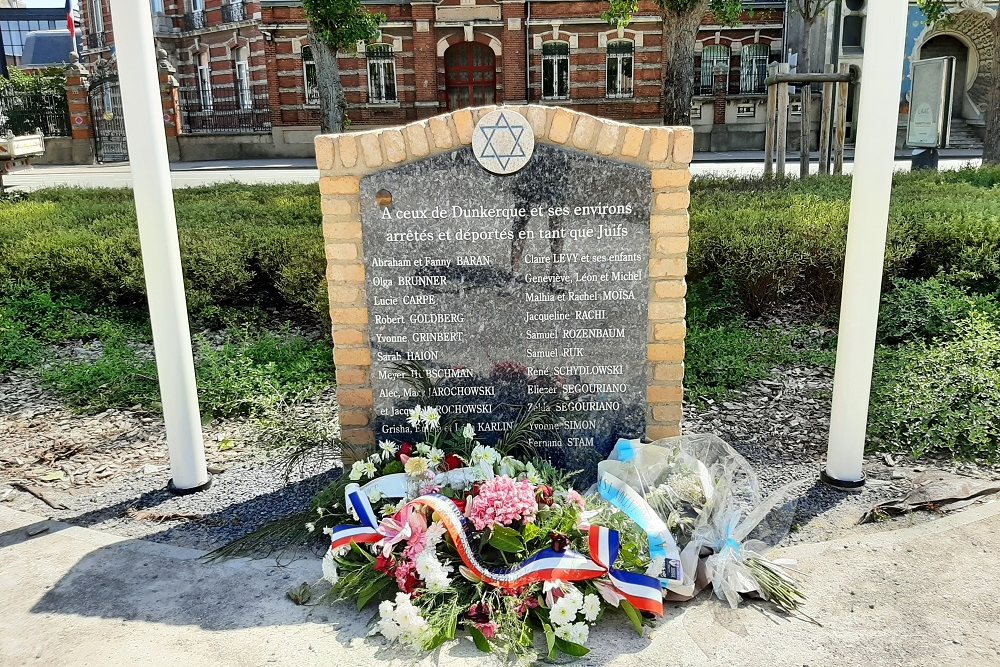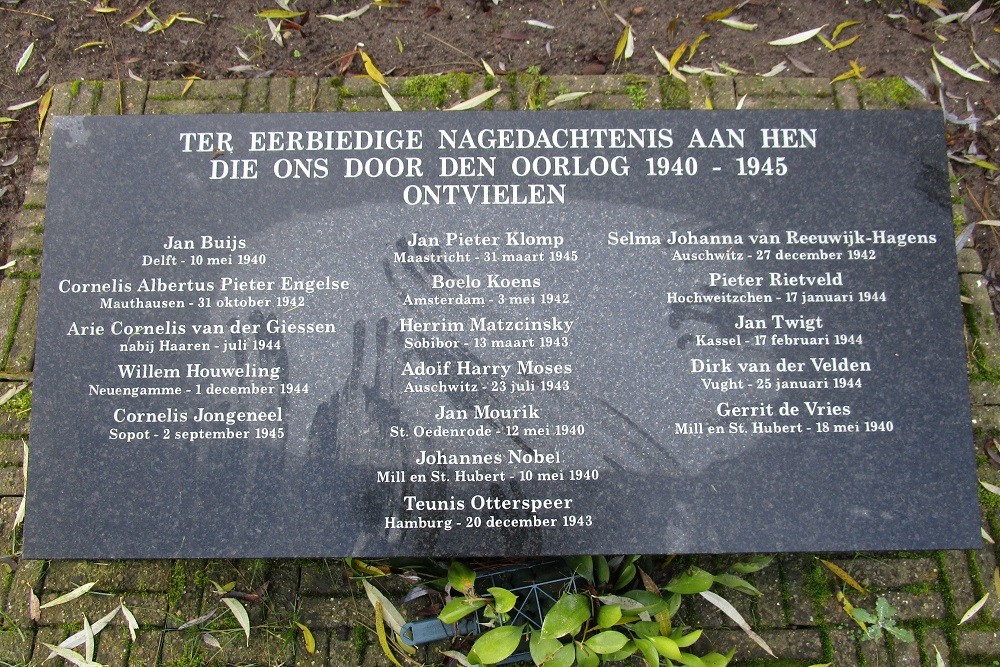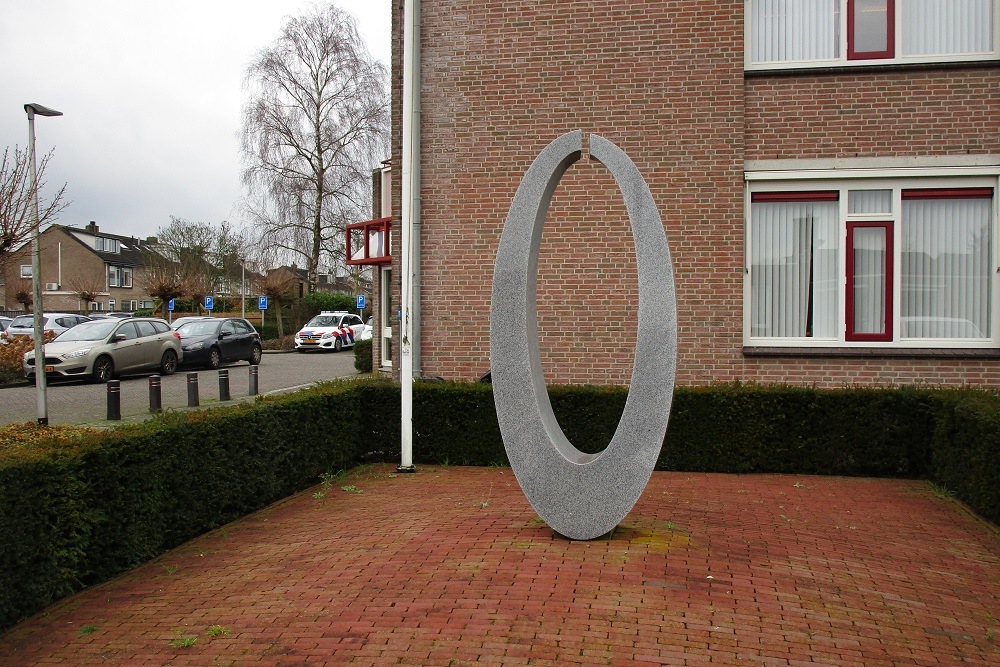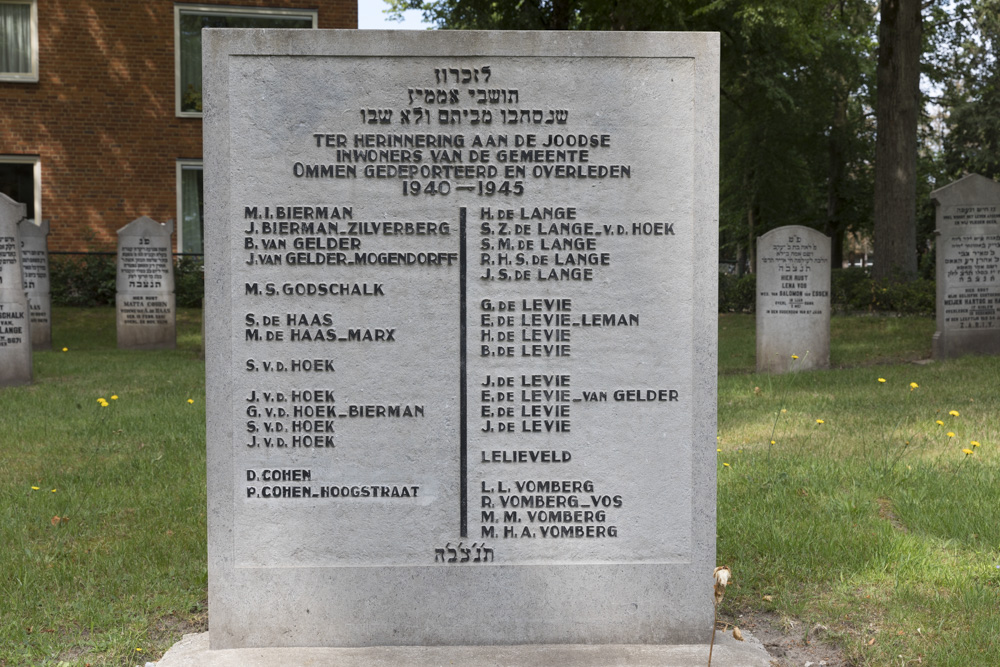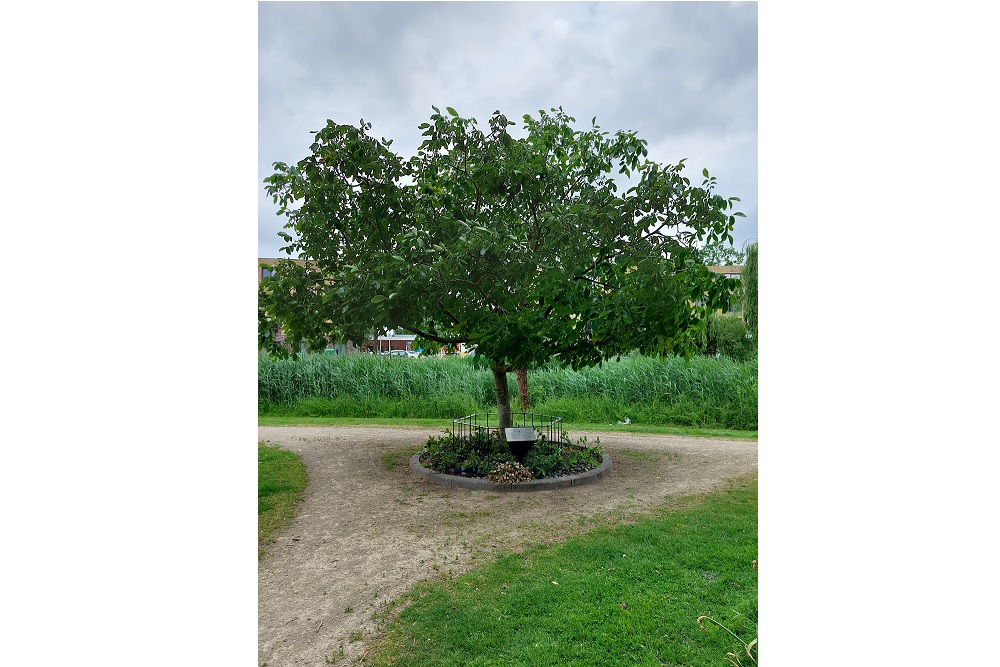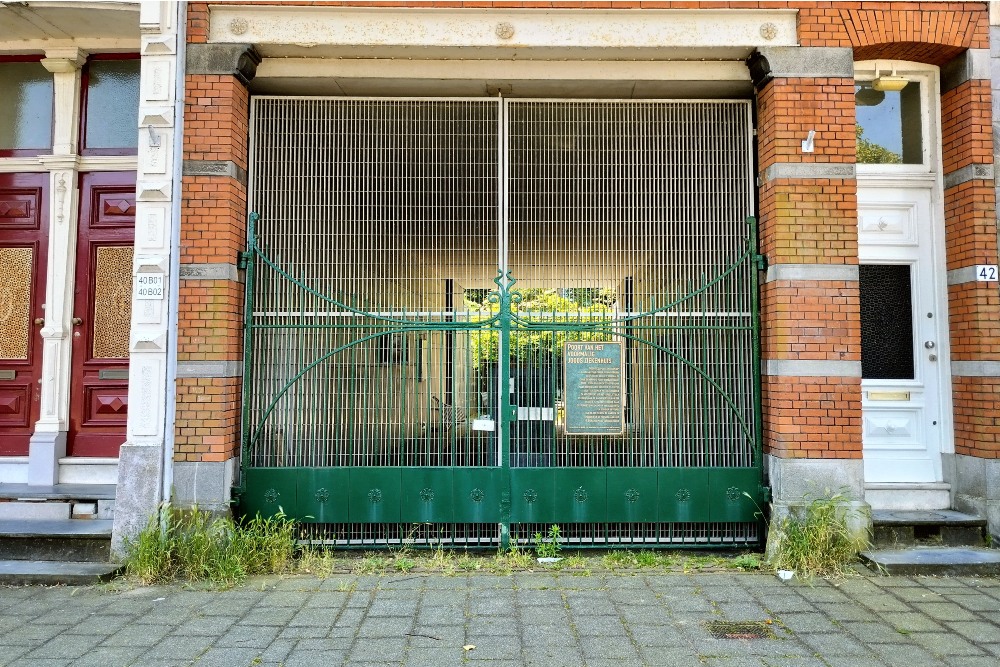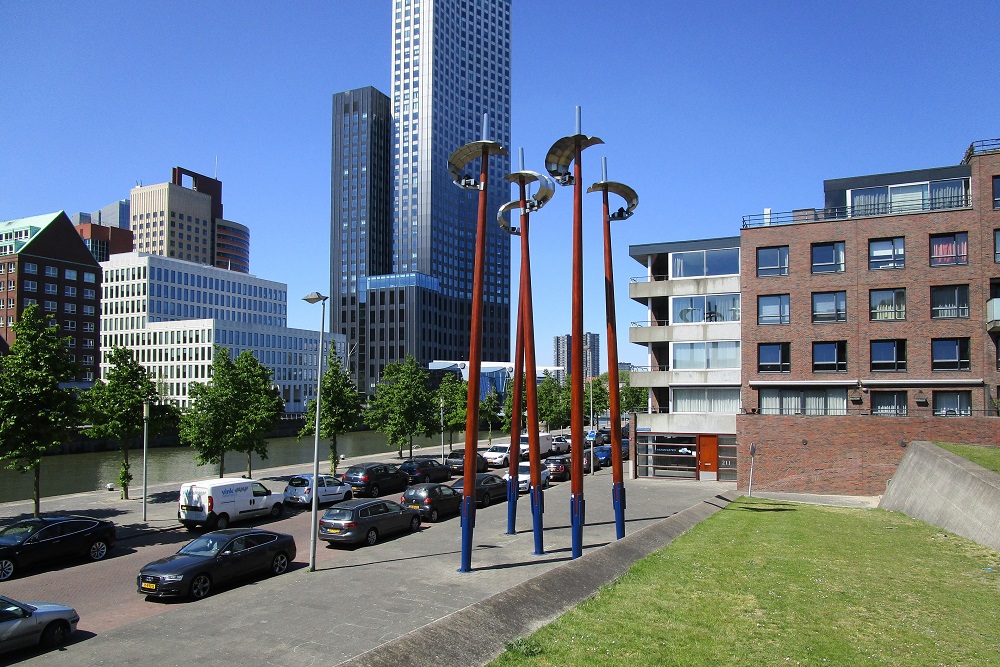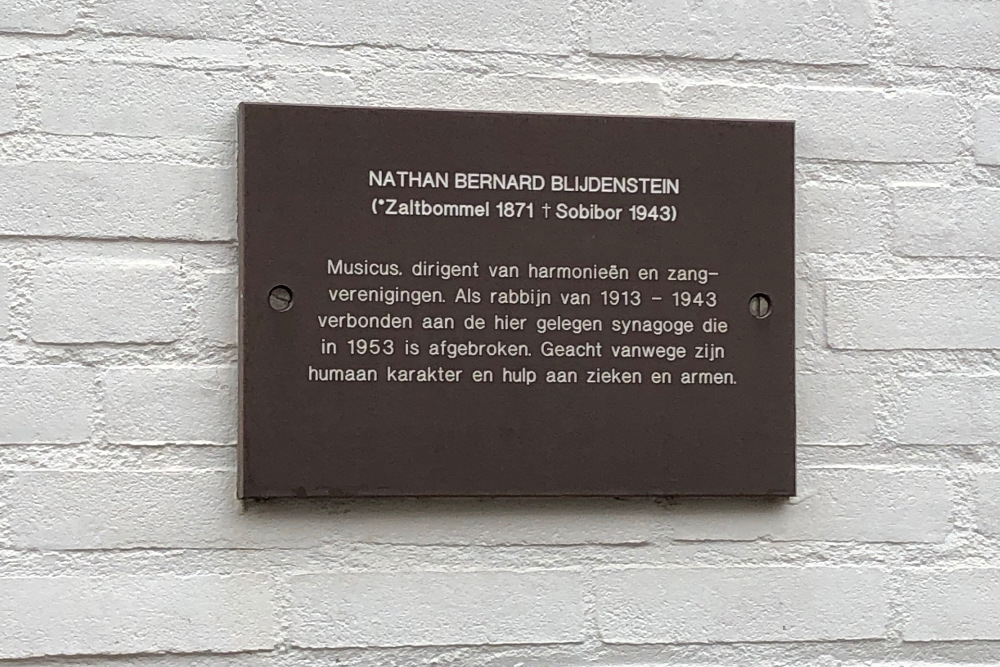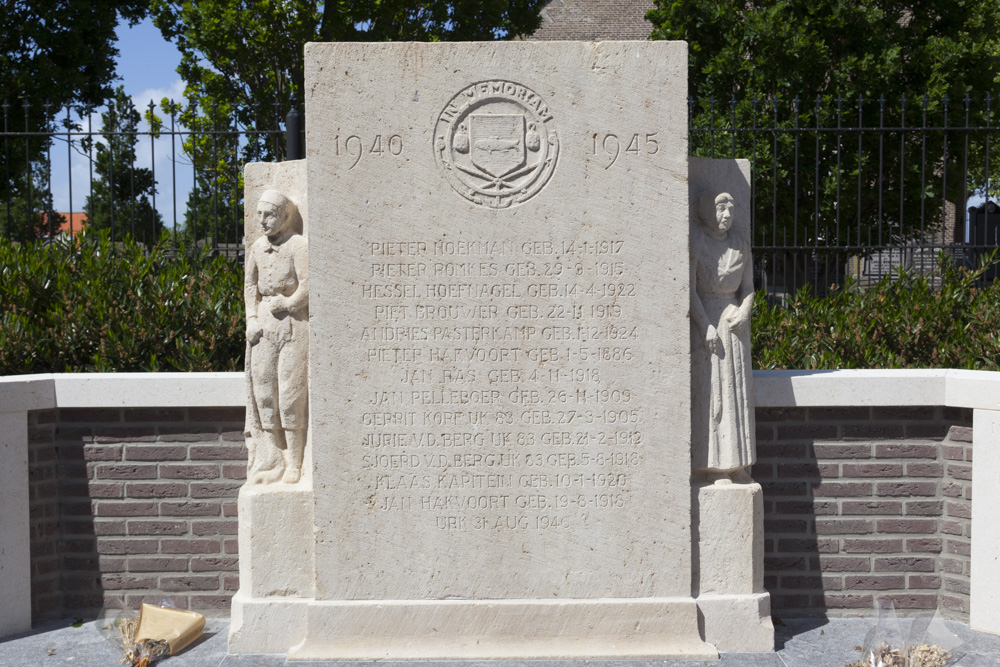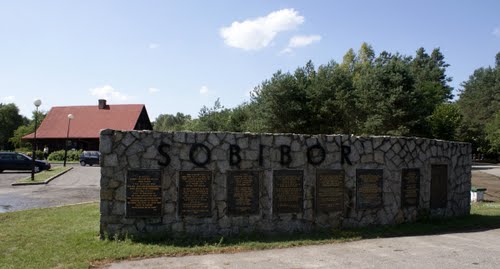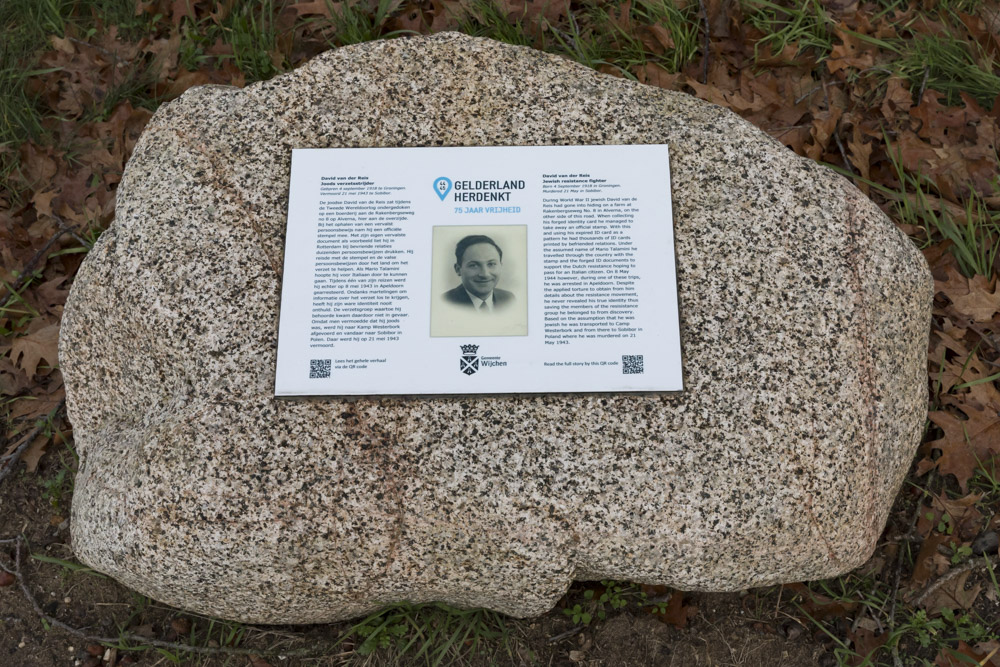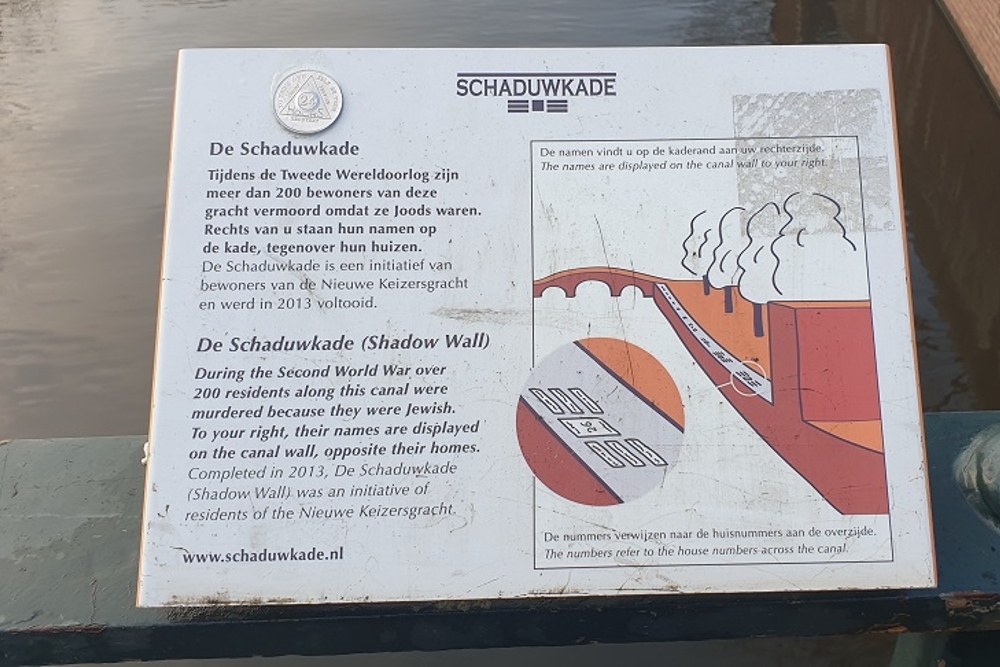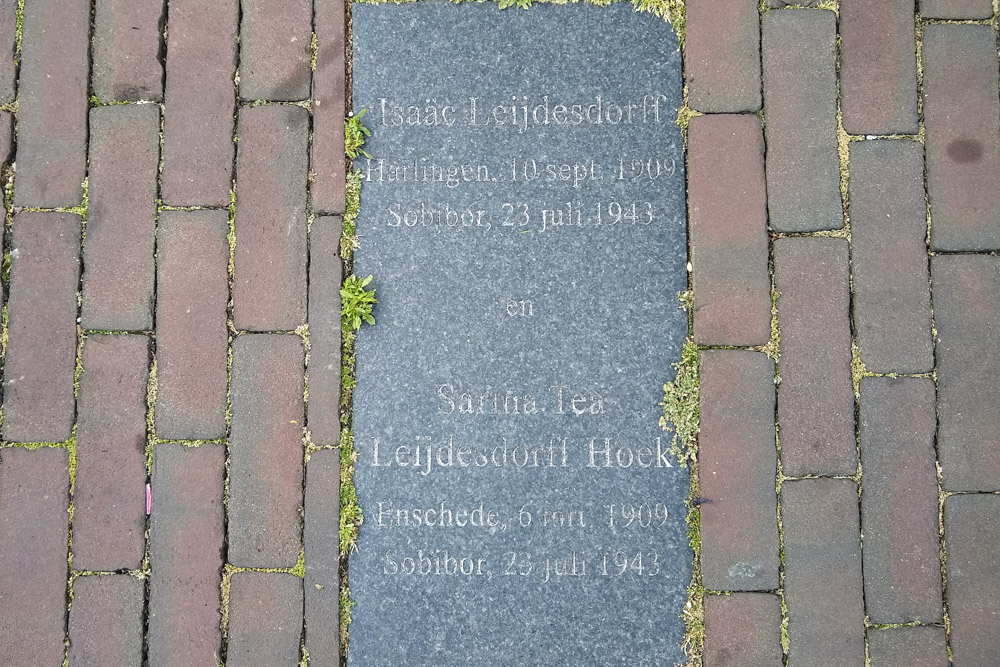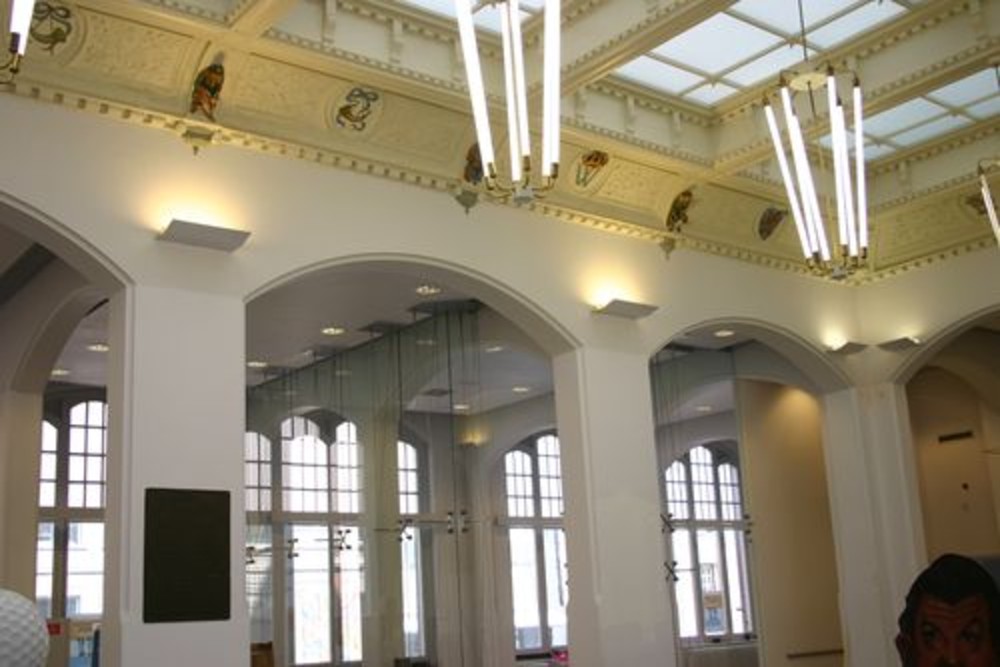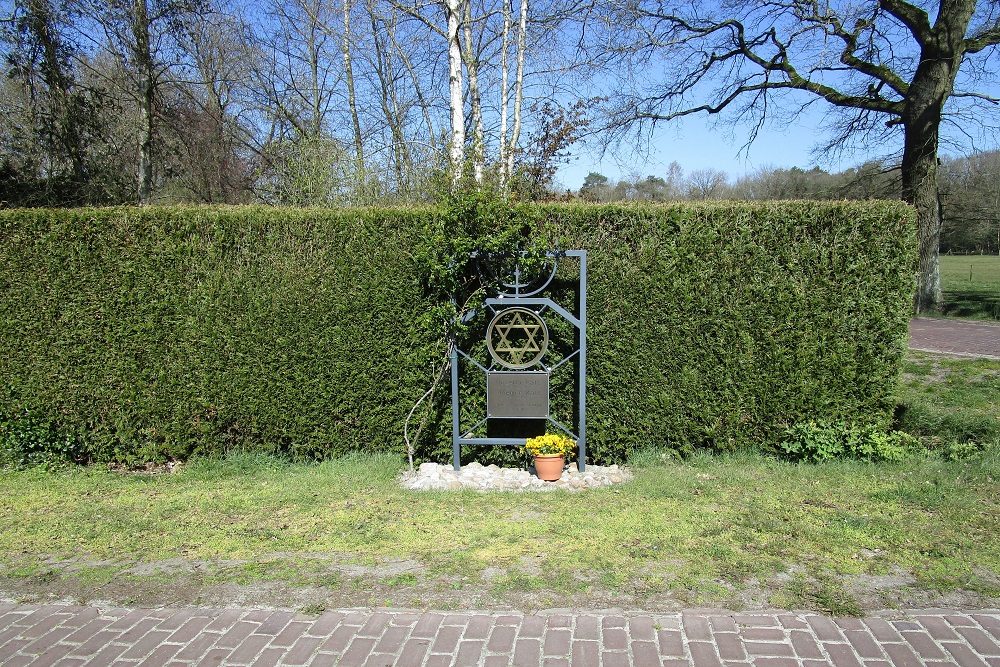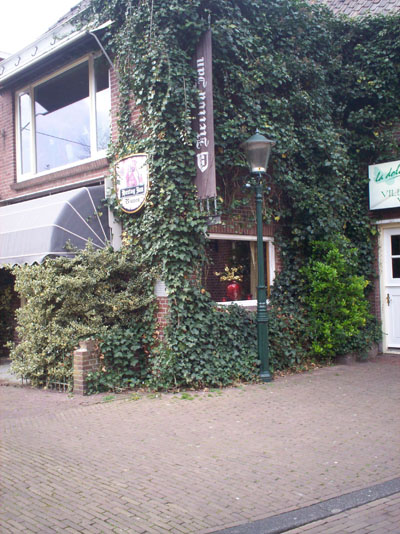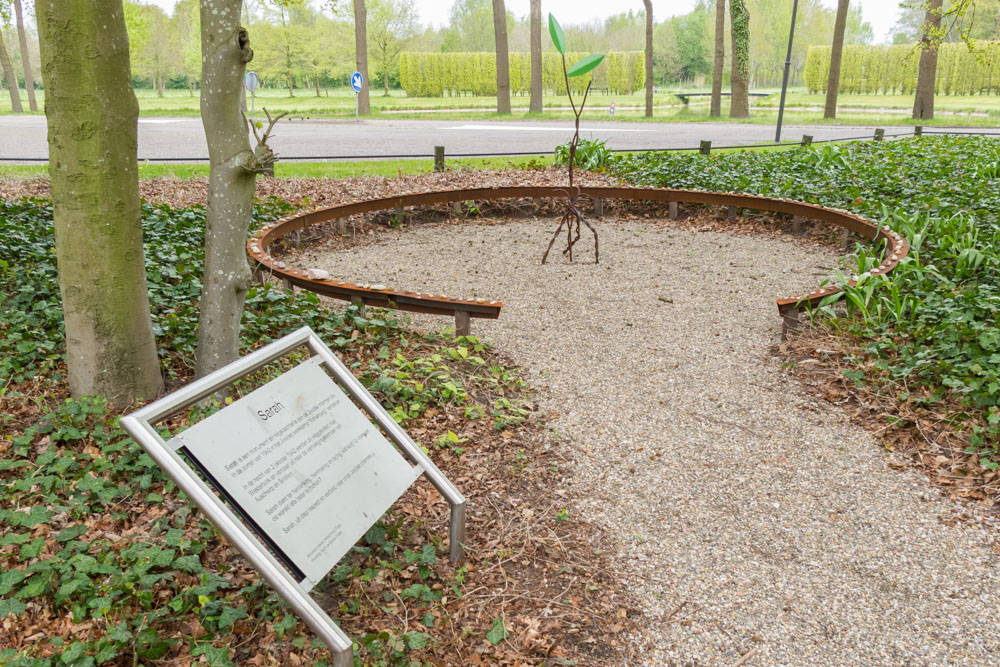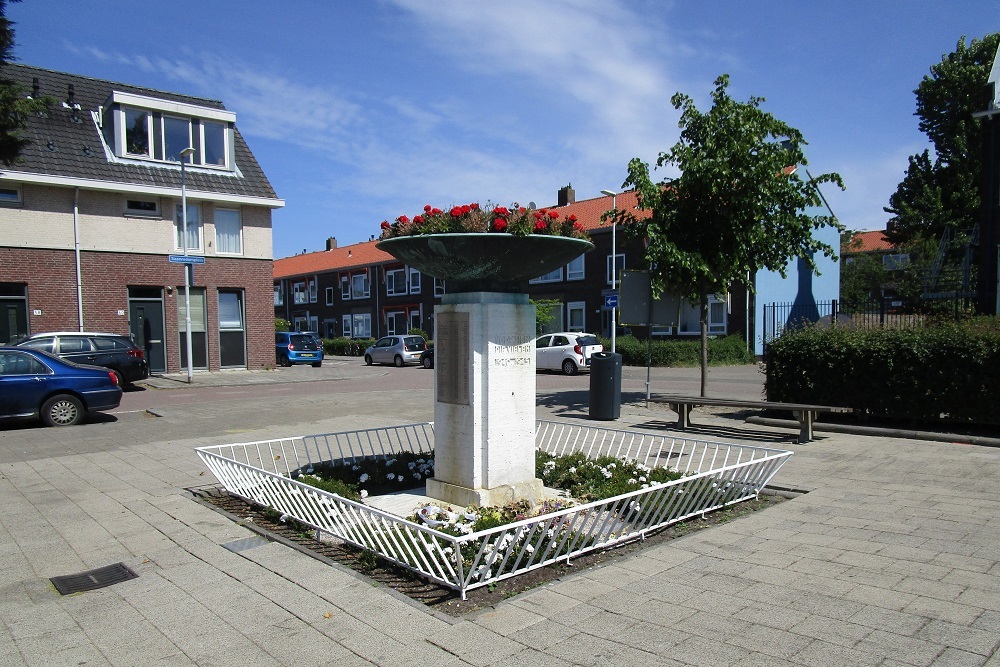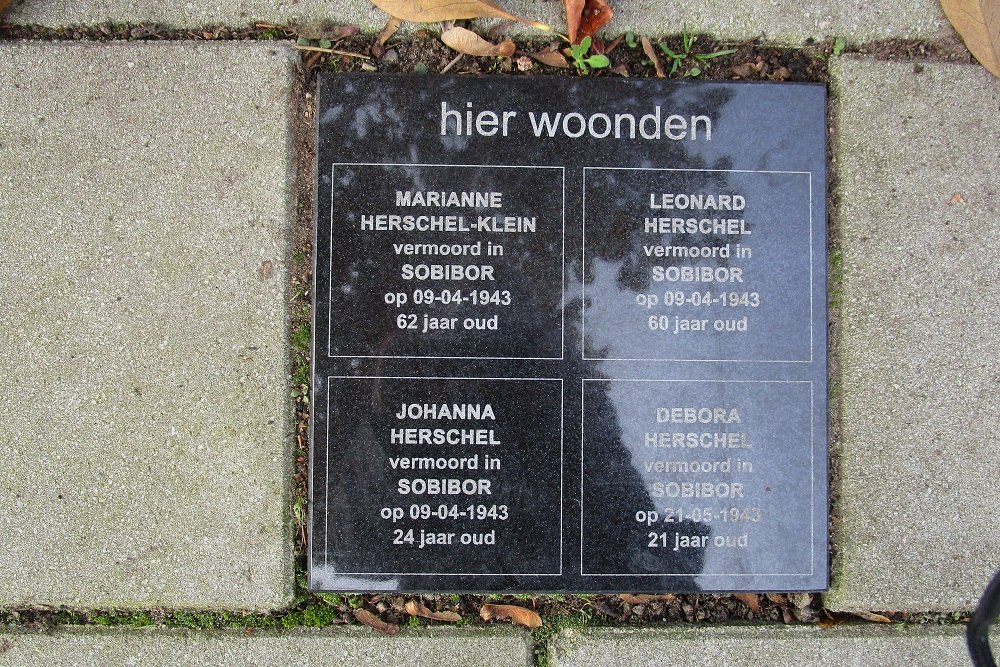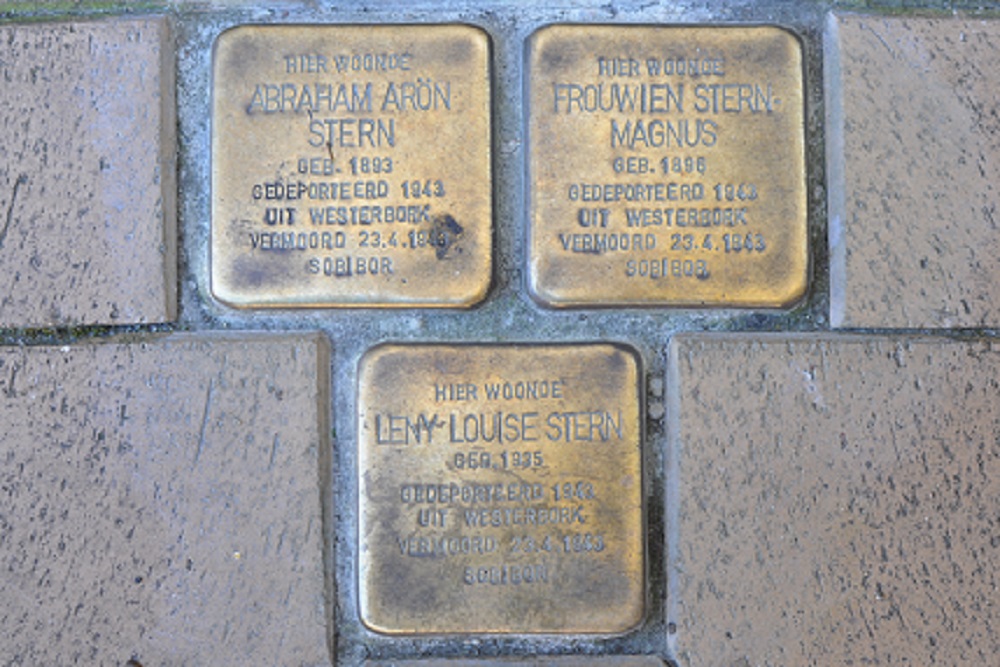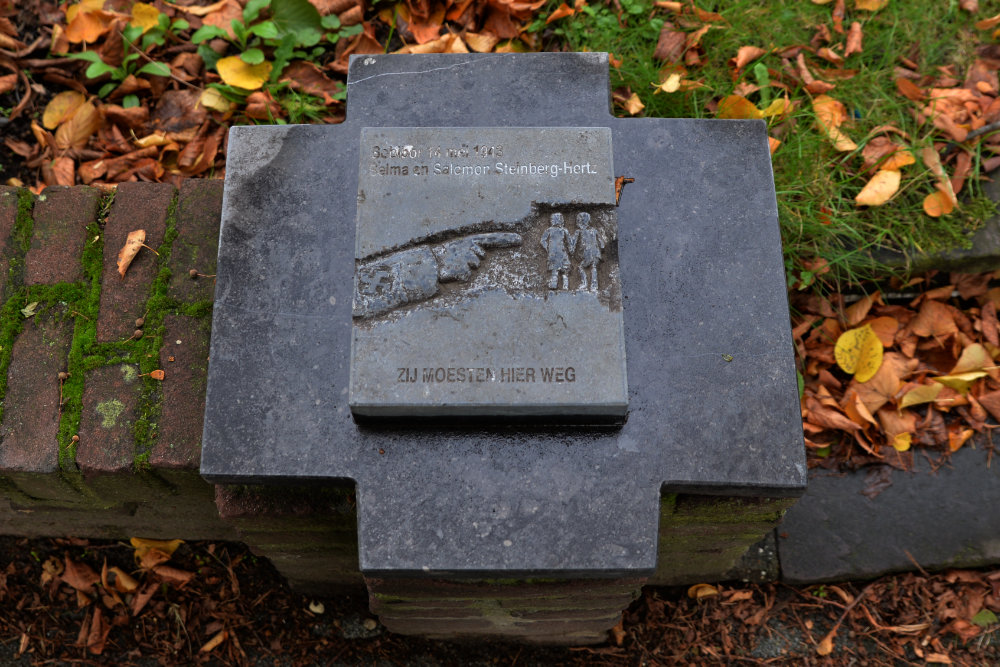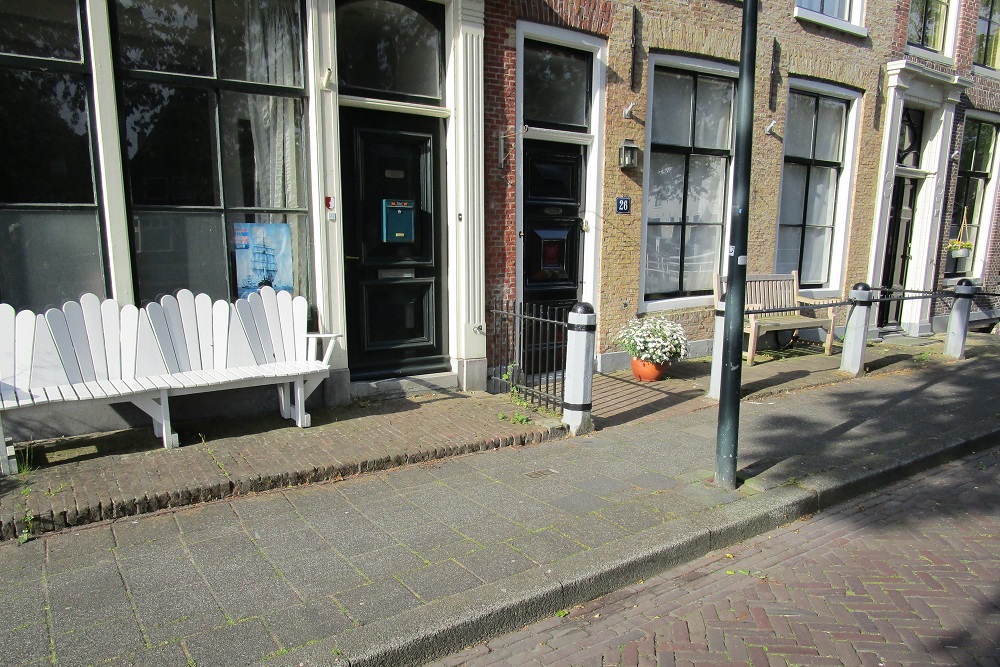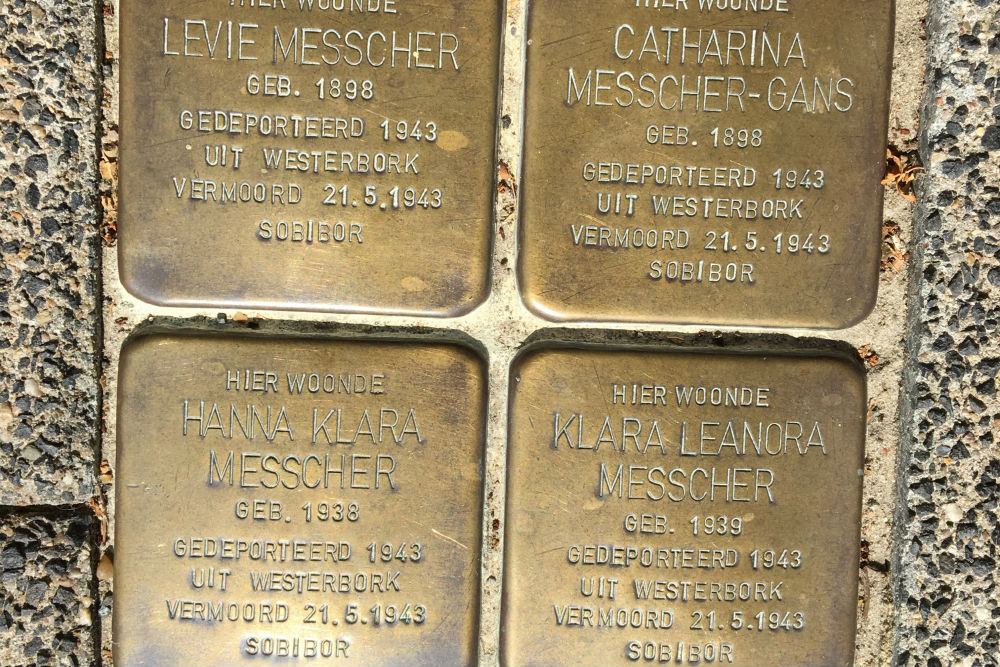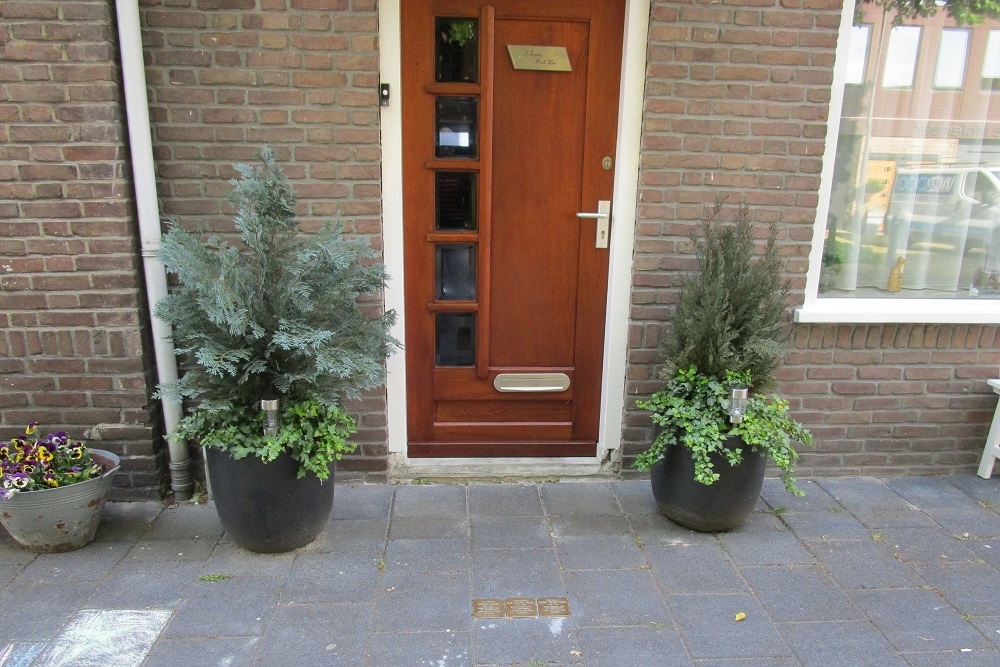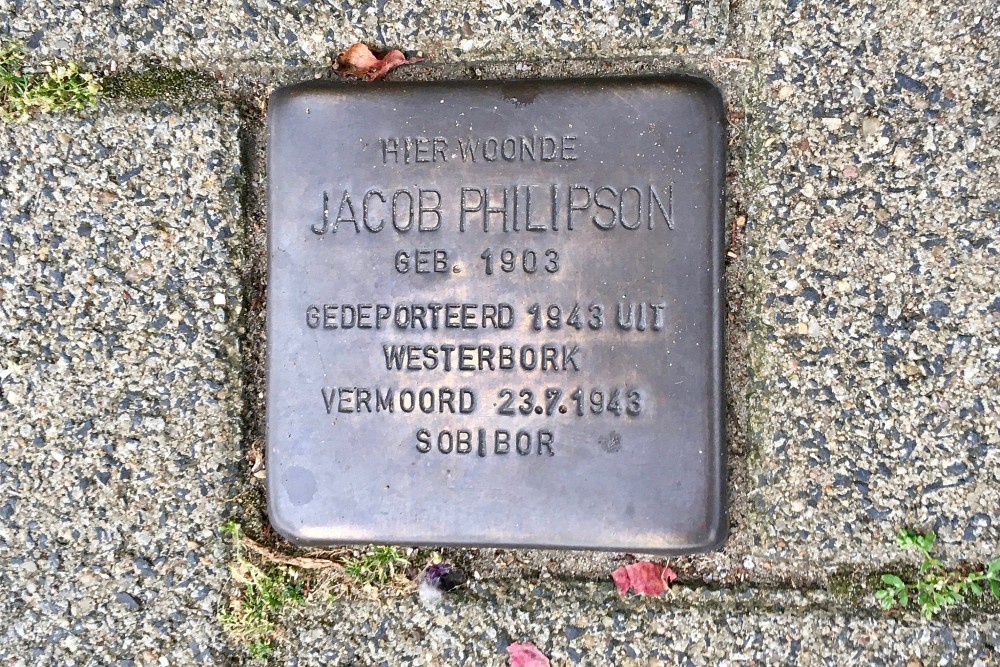Introduction
Sobibor is a small village in southeast Poland in the province of Lublin, on the railway between Chelm and Wlodawa and a few miles distant from the present Polish eastern border with the Ukraine. Had it not been for World War Two, it would have remained no more than an unimportant and unknown hamlet. History though decided otherwise. In the vicinity of the village, across from the local train station and a few miles from the frontier river Bug, the Germans constructed an extermination camp in the spring of 1942 in a remote, wooded and swampy location which was to give Sobibor a sinister place in history.
Sobibor, Camp Treblinka and Belzec formed the three extermination camps that were constructed in connection with Aktion Reinhard. It was the smallest of the three and was made operational as the second camp after Belzec. Sobibor has been in use or a relatively short time, 18 months. The purpose of the camp was just as simple as macabre: to gas as many Jews as possible in the shortest time possible. An uprising of prisoners in October 1943 spelled the end of the existence of the camp. Only a few dozen prisoners survived Sobibor.
Sobibor has played an important role in the extermination of the Dutch Jews. Out of all Jews deported to Sobibor most of them, excluding Polish Jews, came from the Netherlands. In a few months time, between March 2 and July 20, 1943, a total of 34,313 Jews were deported from Westerbork to Sobibor on 19 trains, always departing on Tuesday morning. Only 18 of them returned after the war.
Definitielijst
- Jews
- Middle Eastern people with own religion that lived in Palestine. They distinguished themselves by their strong monotheism and the strict observance of the Law and tradition. During World War 2 the Jewish people were ruthlessly persecuted and annihilated by the German Nazis. . An estimated 6,000,000 Jews were exterminated.
Images
The beginning
The war had passed Sobibor by relatively unnoticed until one day in the first months of 1942 a small German aircraft circled over the village. Hardly anyone took notice and even the arrival of a train on the little station a few days later evoked hardly any interest. Two SS officers got off, SS-Hauptsturmführer Richard Thomalia and SS-Gruppenführer Alois Möser, both on the staff of the SS-Zentralbauleitung (central building office of the SS) in Zamosc and the building experts of Aktion Reinhard. They walked around the station, took some measurements and subsequently disappeared into the forest across from the station.
The purpose of their visit soon became clear. In March 1942, the Germans started the construction of an extermination camp a few miles away from the village. The SS-Zentralbauleitung in Lublin had chosen this location for the establishment of a second camp in connection with Aktion Reinhard: a wood covered, remote tract of land west of Sobibor station and parallel to the railway tracks. Until that time, the only buildings on the premises were a former wooden forester house and a wooden post office two stories high.
In March and April 1942, Richard Thomalia mentioned above, was responsible for the construction of the camp. The work force initially consisted of Polish workers from the area. Building materials also came from the region. The reason was considerations of efficiency: it made the whole operation invulnerable to possible delays due to external interference and the uninterrupted supply of wood and bricks was secured as much as possible in this way as well. Nonetheless, things did not proceed sufficiently fast and in April 1942, the leader of Aktion Reinhard, SS-Obergruppenführer Odilo Globocnik replaced Thomalia by Polizeioberleutnant Franz Stangl. A group of 80 Jews from the nearby ghettoes was delivered as an additional work force. Under Stangl’s direction, completion of the construction of the camp was accelerated. After the work was done, the Jews were shot.
After the war, Stangl described the moment he was ordered to finish construction of the camp. He was ordered to report SS-Sturmbannführer Christian Wirth in Belzec, the inspector of the extermination camps of Aktion Reinhard.
- I drove there by car. On arrival you first came to the small station of Belzec. My God, that stench! It was everywhere. Wirth was not in his office so I was taken to him. He was standing on a hill near the pits. Those pits, full, they were full. I cannot describe it. Not hundreds but thousands and thousands of corpses. There Wirth told me this was the purpose of Sobibor. Wirth said I would surely become commander of Sobibor. I answered I was not suitable for a task like that but Globocnik had ordered me to complete the camp. That it would not become an ammunition depot but a camp to exterminate Jews is something I eventually heard from Wirth. So I stayed in Sobibor. Transports arrived and were liquidated.
The railway facilities in the direct vicinity required necessary adaptations badly. The capacity of the small station was totally insufficient to process the incoming transports. Thus, in the marshalling yard of the little station a number of additional tracks was laid. Some 50 trucks could now be shunted. A siding was made in the main track leading into the camp.
In the second half of 1942, the extermination became operational.
Definitielijst
- Jews
- Middle Eastern people with own religion that lived in Palestine. They distinguished themselves by their strong monotheism and the strict observance of the Law and tradition. During World War 2 the Jewish people were ruthlessly persecuted and annihilated by the German Nazis. . An estimated 6,000,000 Jews were exterminated.
Images
Lay out of the camp
Sobibor was - with Belzec and Treblinka – part of a simple but efficient system of mass extermination whereby, in proportion to the enormous scale of the mass murder, only relatively limited means were used. The sole purpose of the camp was to exterminate as many Jews as possible in the shortest time possible. The lay out and structure of the camp was entirely geared to mass extermination. The camp was relatively small and compact, enabling permanent and strict control over the entire area and everything that was going on inside. The clerical procedures were also very simple. Apart from the relatively small numbers of Jews selected for work in the camp - the so-called Arbeitsjuden – it was certainly not the intention to house prisoners. Almost all prisoners were gassed immediately after arrival. As the camp played no part in the war effort, hardly any industrial activity took place there either.
The camp took the form of a rectangle, measuring 400 by 600 yards and was surrounded by a double wire fence, 10 feet high to which tree branches were attached in order to hide the complex from the outside world. The entire terrain was lit at night by powerful searchlights fed by a special generator. A tall observation tower stood in the center of the camp from where the entire camp could be observed. Smaller wooden watchtowers were strategically placed along the outer perimeter. The outer fence was surrounded by a minefield 15 yards wide. Near the main railway line there were two entrance gates that could be closed with high wooden doors: one entrance for trains, the other for lorries. Initially, the camp consisted of four and later of five sections, each of them surrounded by a barbed wire fence. The purpose of this lay out was to manage the daily course of business as good as possible so unrest, panic and possible revolt in one part of the camp could be quelled quickly before it could spread to another part.
The administration of the camp was located in the southeast of the premises. This was the so-called Vorlager. The entrance gates gave access to this part of the camp. Over the main entrance, there was a large wooden sign with the text "SS-Sonderkommando" on it in Gothic characters. The siding off the main railway line reached well into this Lager. Parallel to the track was the Rampe or platform, a concrete platform where the trains were unloaded. The villa of the camp commander – alias the swallow’s nest – stood across from the platform with on its right the guards room and the arsenal on its left. The main barracks of the SS was also located here with the deadly ironical nickname "Zum lustigen Floh" (in the happy flee). Also in this location the barracks of the Ukrainian guards, the garage and the staff mess.
Lager (camp) I, behind the Vorlager, was surrounded by additional wire fences and on the west side by a deep ditch filled with water. Only one entrance connected the Vorlager with this Lager. Here the barracks of the Jews who were employed in the camp – the Arbeitsjuden, more about them later – were located and the workshops like a shoemaker’s shop, a tailor, a carpentry shop and a forgery. After work, the Arbeitsjuden in Lager I were assembled here from the entire camp – except from Lager III – for roll call and locked up for the night.
Lager II was considerably larger than Lager I and housed the necessary services for the daily running of the camp and the smooth progress of the extermination process. Some 400 Arbeitsjuden found employment here. Newly arrived transports were processed here. Freshly arrived prisoners were taken here. They were to undress in two wooden sheds, one for men, the other for women and children, designated as "dressing rooms." Their possessions were then searched, classified and stored. The former forester house was also in Lager II and surrounded by a high wooden fence. It served as central office and some SS men had their quarters here as well.
From Lager II, the so-called Schlauch – hose – ran to Lager III, the part of the camp where the actual extermination took place. It was a narrow, winding, sandy path, between 9 and 13 feet wide and 150 yards long. It was bordered on both sides by barbed wire with fir branches woven into it. Via this path, the naked victims were herded to the gas chambers located at the end of the Schlauch. Cynically, the Schlauch was also called the Ascension Road. Near the entrance of the Schlauch in Lager II there were stables for cows, pigs and chickens. Not for from the end of the Schlauch near Lager III was a wooden shed called the barber shop; here the hair of the women was shaved off before they were sent to the gas chambers.
Lager III, already mentioned, was located in the northwestern part of the camp. This was the most remote part where the actual extermination took place. Lager III was surrounded on all sides by barbed wire thickly covered with fir branches because what happened there had to be shielded from view from the rest of the camp. In this Lager the gas chambers were located, the mass graves and the barracks for the guards and some 150 Arbeitsjuden. The latter never left this camp alive. The mass graves measured 50 to 60 yards long, 10 to 15 yards wide and 5 to 7 yards deep. The walls of these graves were sloped to ease the dumping of the corpses.
From the Rampe, a narrow gauge railway of some 350 yards in length ran from Lager II to Lager III. People who had died on the train during transport or who were too weak to walk from the platform to the gas chambers were taken to Lager III by this lorry. The railway was also used for all sorts of other transport: large numbers of suitcases were taken from the trucks on the Rampe to the sorting sheds, bundles of clothing went back from the storerooms to the trucks, empty by then, for transport to Germany. Initially, the lorries were pulled by prisoners or horses; later on by a small diesel engine.
The narrow railway was laid under supervision of SS-Scharführer Joseph Vallaster who would be active in Lager III later on. Even his colleagues considered him extremely cruel. In order to complete the line on time before the first transports arrived, he drove the prisoners to an inhuman pace. If prisoners did not work hard enough to his liking or evoked his anger in some other way, he beat them with a huge sledge hammer. During the construction of this line he beat dozens to death this way. Those who escaped with broken bones were of course unable to continue working any longer. They were taken to Lager III and shot.
In the summer of 1943, not long before the liquidation of the camp, in its northeastern part construction was started of sheds and bunkers on order by Heinrich Himmler and what was to become Lager IV. Here captured Red Army weaponry would be stored. Owing to the liquidation of the camp, this section was never put to actual use.
Definitielijst
- Jews
- Middle Eastern people with own religion that lived in Palestine. They distinguished themselves by their strong monotheism and the strict observance of the Law and tradition. During World War 2 the Jewish people were ruthlessly persecuted and annihilated by the German Nazis. . An estimated 6,000,000 Jews were exterminated.
- Red Army
- Army of the Soviet Union.
Images
The gas chambers
The first gas chambers in Sobibor were housed in a brick building in Lager III. There were three of them, measuring 4 by 4 yards. In each room, 150 to 200 people could be gassed simultaneously. Each chamber had an small entrance door inside the building. In the outside wall of the chamber was a much larger folding door, measuring 2 by 2 yards. After the gassing, the corpses could be taken out of the chamber by this door. Extermination took place using the exhaust fumes of a diesel engine in an adjoining shed which were fed into the chambers through tubes.
In the middle of 1942, when construction of the camp neared completion, the first experiments with these gas chambers were conducted. They were attended by Christian Wirth accompanied by the chemist Dr. Karl Blaurock. After the war, SS-Unterscharführer Erich Fuchs described the preparations and the first tests:
- "Wirth ordered me to drive a truck to Lvov to fetch an engine and bring it back to Sobibor. It was a heavy Russian diesel engine, probably from a train or a tank, at least 400 hp, eight cylinders and water cooled. We mounted the engine on a concrete floor at the back of the building and connected the exhaust pipe to the tubes leading into the gas chambers. Next I tried to fire up the engine. Initially it would not start but after I had fixed the ignition and the valves it started. Chemist Karl Blaurock entered the gas chamber with an instrument to measure the concentration of carbon monoxide in the air."
"Next a test gassing was carried out. I remember that 30 to 40 women were gassed in a room. The Jewish women had to undress outside the gas chamber and subsequently were driven into the room by SS guards and Ukrainian volunteers. After they had been locked inside I operated the engine, along with SS-Oberscharführer Bauer. On advice from the chemist I set the engine to a specific r.p.m. so it would not be necessary any more to feed in more gas. After about 10 minutes all women were dead. I collected my tools and saw how the corpses were taken out of the chamber."
From May 3, 1942 onwards, the gas chambers were operational and mass extermination could begin. However, the total capacity of the gas chambers, some 600 persons per gassing, quickly proved insufficient to "process" the transports. Between June and October 1942, maintenance work was carried out on the railway between Chelm and Lublin and transports were temporarily suspended. This delay was used to erect a larger stone building with six gas chambers. Construction work was supervised by SS-Scharführer Lorenz Hackenholt and SS-Unterscharführer Erwin Lambert. They had already gained experience as they had been responsible for the construction of all other gas chambers of Aktion Reinhard and previously for the gas chambers in use by the Nazi euthanasia program, Aktion T-4.
A corridor ran through the center of the new building with the entrances to three gas chambers on either side. Total capacity of these gas chambers was 1,300 persons. When mass extermination in Sobibor was resumed in October 1942, the new gas chambers were operational.
Definitielijst
- Nazi
- Abbreviation of a national socialist.
Images
Camp management and guards
While construction of the camp was still under way, the SS staff moved in. Almost all of them were dedicated Nazis, often of Austrian descent. Many of them had earned their merits in the Nazi euthanasia program and had gained the necessary experience in gassing the mentally disabled. The SS detachment consisted of about 30 men of whom there usually were 17 to 18 present in the camp. The others were on leave on a fixed rotation schedule: three weeks on leave every three months.
The SS lived in relative luxury. They were exempted from military service at the front and their monthly pay amounted to 58 Reichsmark, topped up with a bonus of 18 Reichsmark. They did very well on the food stuffs that was taken from he baggage of their victims. Among the SS it may have been undesired but it was not unusual to embezzle valuables which once had belonged to their victims. Gold teeth, extracted from the jaws of the victims, frequently disappeared in SS pockets as well. The best tailors, shoemakers, cooks, dentists and mechanics among the deported Jews were forced to work for them.
The first commander of Sobibor was SS-Obersturmbannführer Franz Stangl, already mentioned. He came from Altmünster in Austria and was a weaver by profession. He had been employed as a policeman since 1931. Prior to his arrival in Sobibor he had gained experience in the SS euthanasia centers Hartheim Castle and Bernburg. In Sobibor, he seldom showed up in the camp; he limited his contacts with the Arbeitsjuden and those who were to be gassed to an absolute minimum.
Stangl left the camp in September to become commander of Treblinka. He was succeeded by Franz Reichleitner, a former colleague of Stangl from the euthanasia program. Like Stangl, Reichleitner originated from Austria. He was born in Ried in Tyrol and he had years of experience with the Gestapo in Linz under his belt when he became bureau chief in Hartheim Castle. He arrived in Sobibor holding the rank of Polizeihauptman and he was promoted to SS-Hauptsturmführer in February 1943. Reichleitner, who had the reputation of a heavy drinker was to remain in command until the liquidation of the camp. He ruled the camp more meticulously than Stangl but he was more accessible for his subordinates than his predecessor. The Jews rarely saw him though and if they did, they only heard him yelling: "Idiot, faster! Idiot, hurry up;" hence his nickname "the idiot". As far as is known, Reichleitner has been present at the arrival of a transport only once.
Reichleitner’s office assistant was SS-Untersturmführer Johann Niemann, nicknamed "Johnnie." His original profession was house painter and he had made a career for himself in the SS in concentration camps Esterwegen, Sachsenhausen and as "incinerator" in the euthanasia center Hartheim Castle. In 1942 he frequently deputized for the commander and from early 1943 onwards, he was in charge of the day to day running of the camp.
SS-Oberscharführer Gustav Wagner, nicknamed "Welfel" or cub served in Sobibor as some sort of roaming supervisor who was responsible for the work of the Arbeitsjuden in the entire camp. On the Rampe, he also selected those who were suitable as Arbeitsjuden. He originated from Vienna and had previously been active in the euthanasia center Castle Hartheim. His cruelty was feared by all in Sobibor.
Survivor Moshe Bahir described Wagner as follows:
- "He was a handsome man, tall and blond – a real Arian. In normal civil life he was undoubtedly a well mannered person, in Sobibor he was a wild animal. His hunger for killing was boundless. I have seen how he beat two man to death with a rifle for not following his orders since they did not understand German. I remember that one night a group of youngsters, 15 to 16 years old, arrived in the camp. The leader of the group was one Abraham. After a long day’s work, Abraham collapsed on his bunk and fell into a deep sleep. Suddenly, Wagner entered our barracks and Abraham did not hear Wagner ordering him to get up. Wagner went berserk. He dragged the naked Abraham from his bunk and started beating him all over his body. When he had enough of the beating, he drew his gun and shot him on the spot. We all had to watch, Abraham’s younger brother as well."
Lager I and Lager II had their own commanders, subordinate to the camp commander. Initially, SS-Oberscharführer Otto Weiss was commander of Lager I; later on he was replaced by SS-Oberscharführer Karl Frenzel, previously responsible for the Arbeitsjuden in Lager II. Frenzel came from Berlin and was trained as a carpenter. He had earned his merits in the euthanasia program also as builder of gas chambers and "incinerator". He wanted to be a model SS man towards his colleagues and superiors. He took pride in the fact he gained a reputation as one of the most important and cruel SS men in Sobibor. He established his reputation by conducting his personal reign of terror, meting out the most cruel penalties and killing or having Jews killed. In Wagner’s absence, it was Frenzel who was responsible for the selection of Arbeitsjuden.
Kurt Bolender was commander of Lager III from April to July 1942. He also had a career as "incinerator" in the euthanasia program under his belt before he arrived in Sobibor. A case of perjury during his divorce procedure caused his arrest though and he was succeeded by SS-Oberscharführer Erich Bauer. This Berliner was a former tram conductor but loose jobs in the euthanasia program brought him to Sobibor too. He called himself the "gas master." Among the prisoners he was known as the "bath master." In Sobibor, Bauer’s name was synonymous with death.
Every other member of the SS detachment had his own job, for instance leading a certain Arbeitskommando, responsibility for the digging of ditches or rigging barbed wire. Arrival of a transport however triggered so much work causing most SS men to perform tasks in connection with the extermination process. Normal work was suspended and every member of the leadership and the guards had to take on part of the procedure. In addition, every SS man had to take part in the "unloading" of the trucks on arrival of a train sooner or later.
The SS left the actual guarding to a hundred or so Soviet prisoners-of-war who were recruited in the nearby SS training facility of Trawniki. Although they came from all corners of the Soviet Union and even from Poland, the Arbeitsjuden called them Ukrainians, Trawniki men or by the abusive name "karaloechies" or cockroaches. They were subordinate to the SS at all times, whatever rank the Germans had. The Ukrainian company of guards consisted of three platoons. SS-Scharführer Erich Lachmann, a former police officer who had trained the Ukrainians in Trawniki was in command of the unit prior to the arrival of camp commander Reichleitner. Erich Bauer described him as "a boozer who stole like the raven." Survivors testified about his frequent raping of young girls.
Lachmann himself stated after the war: "I had nothing against Jews. I considered them just like any other man. In the early days I even bought my suits from a Jew, Max Süssman who owned a clothing factory in Liegnitz," Lachmann’s birthplace and hometown.
Definitielijst
- Jews
- Middle Eastern people with own religion that lived in Palestine. They distinguished themselves by their strong monotheism and the strict observance of the Law and tradition. During World War 2 the Jewish people were ruthlessly persecuted and annihilated by the German Nazis. . An estimated 6,000,000 Jews were exterminated.
- Nazi
- Abbreviation of a national socialist.
- Soviet Union
- Soviet Russia, alternative name for the USSR.
Images
 Camp commander Franz Stangl in Sobibor with his children Source: http://www.deathcamps.org.
Camp commander Franz Stangl in Sobibor with his children Source: http://www.deathcamps.org.A transport arrives
What happened to all those who arrived in the camp by train day by day was a foregone conclusion: they were gassed immediately. The SS had a contract with the Reichsbahn, stipulating payment for the transport. Children up to 10 years of age traveled at half the standard rate and up to the age of four, they were deported to Sobibor free of charge. The bill was paid with the money and the valuables stolen from the victims.
On average, two trains a day, each consisting of 40 to 60 trucks, arrived, a total of some 2,000 persons who had to be gassed the same day. An engine pushed batches of 20 trucks into the camp via the siding. Railway personnel and train guards were strictly forbidden to enter the camp. Only a selected and trusted group of employees of the Reichsbahn was permitted to come inside. If too many trains arrived exceeding the capacity of the gas chambers, the train or part of it was parked for the night in the marshalling yard outside the camp to be "processed" the next day. After the command "Aufmachen" (open up) was given on the platform and the doors of the trucks had been pushed open, the prisoners were taken out by Arbeitsjuden of the so-called Bahnhofkommando.
There were two different scenarios for extermination in Sobibor. The Polish Jews, transported in cattle trucks, were probably already aware of the real function of Sobibor so their treatment was marked by intimidation and cruelty. On arrival of a Polish transport, SS men in the background kept yelling: "schneller, schneller, raus, raus, rechts, links" (faster, out, right, left) and they and the Ukrainians beat and kicked the prisoners. From that moment on, everything had to go in double quick time, accompanied by yelling and beatings. The guards now kept a very close eye on the prisoners. On the one hand to prevent escaping, on the other, the slightest sign of panic or unrest could be struck down immediately.
When a transport of non-Polish Jews came in though, everything was done to prevent the prisoners from the west from finding out what their fate was. Usually they arrived, neatly dressed, in passenger coaches. Prior to departure the Jews had been informed that they were being taken to a labor camp in the Ukraine. The majority of them believed it. On the one hand it was utterly unimaginable what was in store for them here, on the other hand, rumors and stories about Aktion Reinhard were not taken seriously outside Poland and certainly not broadcasted world wide. The SS managed to keep their victims ignorant about their fate until the doors of the gas chambers were closed.
Thus, on arrival of such transports, merry tunes were played by the camp orchestra, consisting of experienced musicians. The members of the Bahnhofkommando were neatly dressed in blue overalls and wore caps with the sign BK on it when transports from the west arrived. They helped people disembark, took their luggage and even gave them a receipt for it. People were so ignorant about what was in store for them that some asked the members of the Bahnhofkommando if they had finally arrived in the Ukraine, how far to travel to the next station, when the next train would depart and where they could change trains. Others even wanted to tip the Bahnhofkommando for carrying their suitcases. The Bahnhofkommando played its role as a group of tragic actors. Disclosing the secret of Sobibor spelled certain death; Karl Frenzel was always hanging around.
On the platform, men and women were separated, children remained with their mothers. The sick would be taken to a lazaretto for treatment. Heavy luggage was to be left behind on the platform. When new Arbeitsjuden were needed, SS men walking between the rows of prisoners called out if there were any tailors, carpenters, shoemakers and metalworkers present. Did it make sense to report for that? You did leave your brothers, sisters, parents and children behind on the platform. Who knows for how long as they would travel further to the Ukraine. Sometimes the SS selected people for work in the camp entirely at random. The chosen were taken to Lager I immediately.
Next, the large mass of people, women and children first, then the men, were escorted through a gate with the sign Sonderkommando Sobibor over it, to a large shed in Lager I where hand luggage and personal belongings were to be left behind. As soon as the prisoners had left this shed, Arbeitsjuden called Paketenträger moved in. They quickly took all hand luggage to adjoining sheds where the contents was dumped on large tables and sorted: money with money, brushes with brushes, lipstick with lipstick, glasses with glasses and so on. Papers, documents, pictures etc. were immediately burned in an oven.
Meanwhile the prisoners were standing outside again, on a field in the center of Lager I where they were spoken to by SS-Oberscharführer Hermann Michel, nicknamed the preacher. He was wearing a white coat to give the impression that he was a doctor. The victims still had no idea what was in store for them. They saw neatly laid out gardens with flowerbeds and freshly painted placards with signs like "canteen" and "shower rooms." Michel made them believe they had arrived in a transit camp. From here they would be transported to various labor camps further east. Before traveling on, they had to take a shower here, according to the strict hygienic rules, moreover their clothes would be disinfected.
Apologies were made for the long trip and the fact that housing was not immediately available for them. Young boys walked among the crowd distributing small pieces of string. The request was to tie their shoes together. Valuables could be left behind at the desk of the chief of the camp administration, SS-Oberscharführer Alfred Ittner, nicknamed the cashier. In June 1942, he was succeeded by SS-Scharführer Herbert Floss who went about his task with equal dedication. Not to worry, everything was painstakingly recorded and after the shower, everyone would get his or her valuables back.
Former prisoner Ada Lichtmann remembers:
- "We heard word by word how SS-Oberscharführer Michel, standing on a small table put the people at ease in a convincing and soft voice. He promised them, all of their belongings would be given back to them after the shower and he said that for Jews the time had come to become productive members of society. They would be sent from here to the Ukraine where they could live and work well.
The elderly, the sick and those who could not walk were told they would be taken to a sick bay for medical treatment. Actually, they were taken to Lager III on lorries, drawn by humans or horses, straight away to ditches where they were shot immediately."
- "As you have been on the train for a long time, sanitary methods are necessary. Therefore you will have to undress in order to take a shower in the bathhouse further away. Your clothes will be guarded. You will hand over gold and jewelry at the desk. You will have to remember the number you have been given in order to easily retrieve your belongings later. There is soap and a towel for two.
For "disinfection", the groups were led to a shed where they had to undress. During the first weeks, this took place in the open air though. Again, women and children went first. In the dressing rooms, the semblance of normality was also kept up. There were train schedules hanging on the walls and posters, urging people to maintain order and cleanliness.
Subsequently the naked prisoners, provided with a piece of soap, were taken to the gas chambers along the Ascension Road, regardless of the weather. The group was led by an SS man and five or six Ukrainians took up the rear. Near the end of the path there were three interconnected sheds. There, a group of Arbeitsjuden called the barbers, shaved the heads of the women. That was done speedily with a few strokes of a clipper. Some women sometimes asked not to cut their hair too short since it looked so ugly. An SS man stood in the middle of the room to ensure the barbers would not tell the victims anything about their imminent fate.
The building housing the gas chambers looked entirely normal to the unsuspecting prisoners. It was, as said before, a large stone building, on the outside wall a placard with the text "Baderäume" or bathrooms and a Star of David. The gas chambers themselves looked like large shower rooms, opening on both sides of a central corridor. Each room could be filled with 200 persons. After filling, the doors were hermetically sealed off and subsequently the engine was started. Soon, a hideous screaming could be heard from the chambers. It gradually diminished in 5 minutes and after 20 to 30 minutes everyone inside was dead. The loud noise of the engine and the thick walls muffled the screams sufficiently to make them inaudible for the next group of prisoners that was listening to the Michel’s soothing speech in the meantime. Hardly a few hours had passed.
A Jewish officer of the Red Army who was made a prisoner of war, Aleksandr Pecherski, later on one of the leaders of the uprising in the camp, was transported from Minsk to Sobibor on September 18, 1943 along with a group of 2,000 Jews. He gives an impression of the speed with which the extermination took place:
- "On the fifth day, the train arrived at some remote station. In the dark I saw a white sign with the word Sobibor. We remained locked in during the night. In the morning of September 23, an engine pushed the train into the camp. Tired and hungry we got out and SS-Oberscharführer Gomerski shouted: ‘Furniture makers and carpenters without relatives, up front.’ 80 men, mostly Jewish prisoners-of-war came forward and we were herded to a shed somewhere in the camp. Later that day, a Jew came to me. He returned from some kind of labor and while we were talking, I saw grey smoke rise up in the northwest and I smelled something burning. I asked him ‘What is burning there?’ He answered: ‘They are burning the bodies of your friends who arrived with you this morning."
German engineer Otto Weisbecker, employed in the Organisation Todt, also became familiar with the speed of the extermination process in the summer of 1943.
- "I was in charge of a building site in the city of Lida where some 1,400 Jews were employed. [..] One day I was ordered to take the Jews to Lublin in order to do some work there. The same day, they were loaded onto a train, 60 men in each truck. They arrived in Sobibor. [..] Next morning I arrived in the camp and was taken to the commander. He was in the mess and there was a large plan of the camp on the wall. I noticed immediately it was impossible to house 1,400 Jews in those barracks. In answer to my question where he had housed those Jews who had arrived yesterday, he told me that of those 1,400 Jews of that transport, not one of them was still alive.
After the gassing, the corpses were dragged out of the gas chambers through the backdoor by the Arbeitsjuden in Lager III. Gold teeth were extracted and all body cavities were checked for possibly hidden valuables. The corpses were loaded onto the lorries of the narrow gauge railway and transported to the mass graves nearby. Meanwhile the Arbeitsjuden in the Vorlager cleaned the trucks, the collected possessions were sorted by them and packed in big bundles to be returned to Germany. The empty train was driven away as soon as possible, making room on the Rampe for the next transport.
Initially, the corpses were buried in mass graves. They were dumped in large pits and covered with lime. In the heat of summer, the corpses swelled and after the gas created by the decomposition had escaped, the corpses shrunk and the Arbeitsjuden covered them with sand. From the late summer of 1942 onwards, the mass graves were opened up again and the remains burned. From then on, the corpses were burned over large pits by a special squad of Arbeitsjuden on a grid made of rails.
The reason for this change was threefold. First, the summer of 1942 was very hot. The stench of the tens of thousands of decomposing corpses was unbearable and permeated everything. Second, the subsoil water was high in Sobibor as it lay very close to the river Bug. After the snow had melted in the spring of 1942, the area south of the camp turned into a swamp. The Germans were afraid their drinking water would be contaminated by the decomposing corpses and that typhoid would erupt. Finally, it was feared that one day someone would stumble upon the mass graves and unveil the secret of Sobibor.
Large amounts of ashes that were left behind after the liquidation of the camp are now being preserved in a hill in the former camp grounds.
Definitielijst
- heat
- High-explosive anti-tank warhead. Shaped charge projectile to punch through armour. Used in e.g. bazooka or in the Panzerfaust.
- Jews
- Middle Eastern people with own religion that lived in Palestine. They distinguished themselves by their strong monotheism and the strict observance of the Law and tradition. During World War 2 the Jewish people were ruthlessly persecuted and annihilated by the German Nazis. . An estimated 6,000,000 Jews were exterminated.
- Red Army
- Army of the Soviet Union.
Images
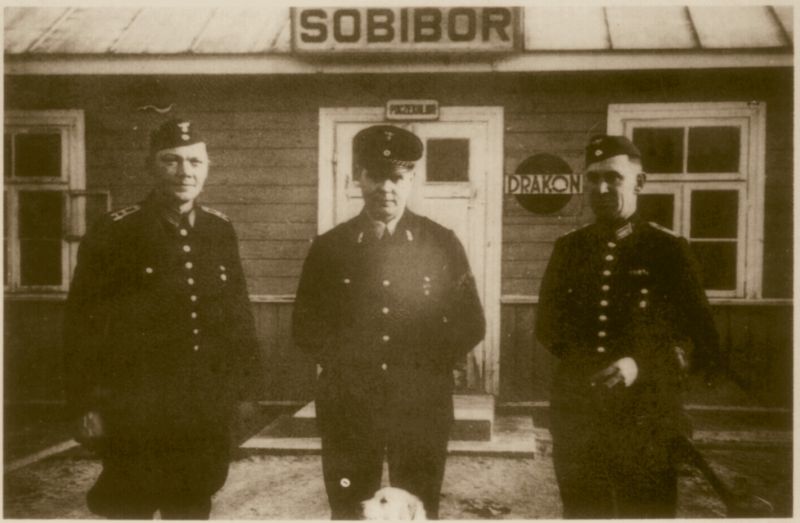 Personnel of the Reichsbahn in front of the station in of Sobibor Source: http://www.ushmm.org.
Personnel of the Reichsbahn in front of the station in of Sobibor Source: http://www.ushmm.org.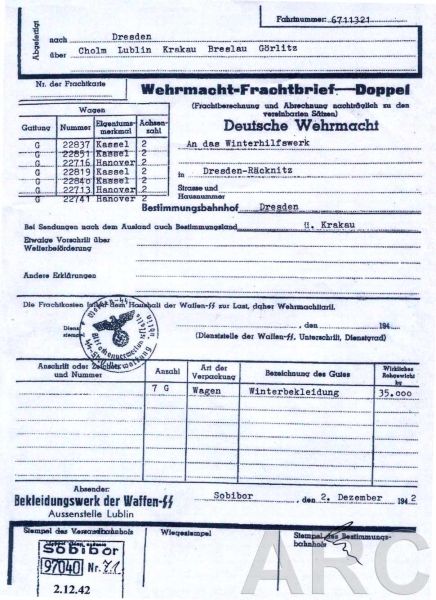 Bill of lading for 77.000 lbs of winter clothing from Sobibor to Dresden Source: www.deathcamps.org.
Bill of lading for 77.000 lbs of winter clothing from Sobibor to Dresden Source: www.deathcamps.org. Hermann Michel, the "preacher" Source: http://www.deathcamps.org.
Hermann Michel, the "preacher" Source: http://www.deathcamps.org.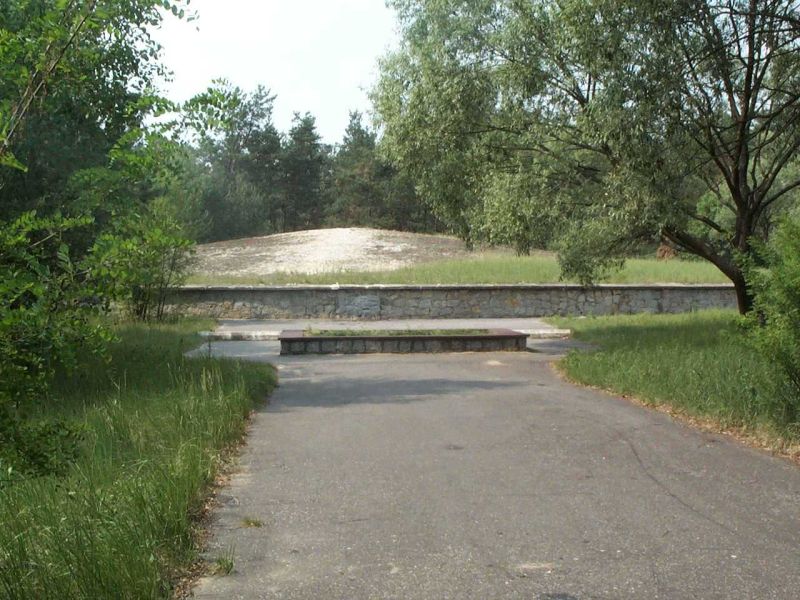 The Hill of Ashes in the former camp grounds Source: http://www.berea.edu.
The Hill of Ashes in the former camp grounds Source: http://www.berea.edu.Life in the camp
Chances of survival in Sobibor were almost non-existent as nearly all those arriving on the Rampe were gassed immediately. Even in Camp Auschwitz-Birkenau, where an estimated 1,1 million Jew were exterminated, there was always that small chance to endure the privations. In extermination camps like Sobibor, only the Arbeitsjuden were kept alive for a short time.
As far as there was any question of a camp life, then it only applied to the approximately 800 Arbeitsjuden. After selection on the Rampe they were taken to Lager I. There they were registered and housed in a few sheds. Most of them did not realize yet they were to work in an extermination camp. The frequently asked question, "experienced" fellow prisoners were asked, like when they would meet their relatives again was answered by the information that they were in Sobibor, the location where Jews were being gassed. The stench was all pervading. The red glow over the trees in the distance did not spell any good either.
Some 600 prisoners were employed in the Vorlager and Lager I and II. Some 200 prisoners were allowed to spend their last weeks in Lager III. The two groups did not have any mutual contact, they lived and worked strictly separated. The Arbeitsjuden outside Lager III did all sorts of work for the SS, making boots and clothing, maintenance of vehicles and caring for animals. In addition they were indirectly involved in the extermination process by sorting clothing and other belongings, cleaning the trains, cutting wood for the funeral piles and shaving the women.
The Arbeitsjuden lived in constant fear of death. Each day, they were marched in rows to and from work, escorted by SS men and Ukrainians and forced to sing while on the way. Whoever dared walk out of step was thrashed. During evening roll call, prisoners who had done something wrong at work that the guards did not like, were punished. The victims had to count the number of lashes themselves and if they did not call out loud enough or lost the count, the lashing went back to square one.
The violence was entirely at random. Survivor Aizik Rottenberg remembers:
- "We were being terrorized continuously. One day, a prisoner was talking to a Ukrainian guard. An SS man came by and shot him out of hand. On another occasion we had to transport sand to freshen up the garden. Karl Frenzel walked by, drew his gun and shot the prisoner next to me. Why? I still don’t know."
In the winter of 1942, the number of transports decreased. The capacity of the rail network was utilized as much as possible for the transfer of supplies to the eastern front where the Wehrmacht suffered severe setbacks. The long pause between the transports and the isolation of the snowed in camp had a negative influence on the SS. They got bored, irritated and the Arbeitsjuden got the short end of the stick.
SS-Scharführer Paul Groth was an extreme sadist. He was often accompanied by his huge dog Barry, drilled to attack prisoners and tear them to pieces. Groth became notorious for the "games" he invented. One day he ordered four Jews to carry him around like a king while he threw burning pieces of paper on their heads. He also had prisoners jump from roofs with umbrellas, like parachutists. Anyone spraining an ankle or breaking a leg was taken to Lager III and shot. A favorite pastime of his was organized beatings: prisoners had to run the gauntlet between rows of Ukrainians with whips. One day he ordered an extremely skinny prisoner to drink a bottle of vodka and eat two pounds of sausages within a few minutes. Then he tore open his mouth and urinated in it. Another game of his was tying up the bottoms of the trouser legs of a prisoner and then a hungry rat was showed into his trousers. When the prisoner made a move, he was shot.
For a while, Groth appeared to be less cruel. Three pretty teen age girls arrived in the camp on a transport from Vienna. One of them, Ruth, became his maid and mistress. He stopped abusing other Jews albeit for a short time only as it was against SS regulations to have sexual relations with Jewish women; in doing do he would bring dishonor upon the master race. While he was on leave, commander Reichleitner had him transferred to Belzec.
The long days of winter had their influence on Erich Bauer too. As there was little work to do in Lager III owing to the decreased supply of Jew, he turned to booze. He had a private bar in his room in the swallow’s nest. There, Jews were made to mix drinks for him or make advocate. He spent hours dead drunk, with a picture of his wife and children and a portrait of the Führer in front of him. If a prisoner spilled booze or broke a bottle, he was to lick the floor clean.
The work of the Arbeitsjuden in Lager III literally led to insanity as they worked in the focal point of he extermination process. They were to drag the corpses from the gas chambers, check for any valuables in or on the corpses and subsequently bury – and later on – burn them. It was no exception they discovered friends or relatives among the dead. Suicide was a way out. While in the long run they were unable to sleep or eat, total exhaustion set in. Most of them simply gave up and died. Relatively little is known about their lives and deaths, being completely isolated from the other Arbeitsjuden in the camp. Characteristic is the danger prisoners faced when taking kettles of food to Lager III. Sometimes the gate to Lager III was opened while those who would bring the food were on their way to the Lager. They were immediately herded inside and nothing was ever heard of them.
A cook, Hershel Zuckermann once tried to contact the prisoners in Lager III:
- "We made soup in our kitchen for Lager III and the Ukrainian guards usually came to fetch the kettles. Once I dropped a message in the soup, packed in dough asking: ‘In God’s name brother, let me know what you are doing there.’ The answer came back, glued to the bottom of a kettle: ‘You shouldn’t have asked. Here, people are gassed and we are to bury them’.
To make matters even worse, in Lager III was a young, 18-year-old Kapo Franz who was utterly unaccountable. Fatigue and the horrors took their toll of him too. He considered himself an SS man and Jews as vermin that had to be destroyed. Just like the SS officers he wore shiny black boots and he lashed at will with his whip.
Out of sheer desperation, Arbeitsjuden from Lager III once attempted to dig a tunnel to the outside world. Inevitably, it was discovered. From 100 Arbeitsjuden the SS selected every second Jew and had them stand in line. While the other Jews were forced to sing a romantic German song the 50 selected Jews were shot, each paired up with one of the singers.
As far as is known, not a single Arbeitsjude from Lager III survived Sobibor.
Finally, the camp orchestra must not remain unnoticed. In the three camps of Aktion Reinhard, the SS organized bands with the intention to cheer up their own lives, to humiliate the prisoners and to muffle the screaming emanating from the gas chambers. So in Sobibor as well. Not just an orchestra but a mixed choir directed by the a Dutch woman, Moniek, who was awarded the title Kapo for this. The Polish song "Goralu czy ci nie zal", sung and played after work was very popular. On the way to and from work, SS songs had to be sung as well. Ordered by Gustav Wagner, improvisation led to a song with the bitterly ironic text:
- "Wie lustig ist da uns Leben,
man tut uns zu Essen geben,
wie lustig ist’s in dem grünen Wald,
wo ich mich aufhalt"
Definitielijst
- Auschwitz-Birkenau
- The largest German concentration camp, located in Poland. Liberated on 26 January 1945. An estimated 1,1 million people, mainly Jews, perished here mainly in the gas chambers.
- Führer
- German word for leader. During his reign of power Adolf Hitler was Führer of Nazi Germany.
- Jews
- Middle Eastern people with own religion that lived in Palestine. They distinguished themselves by their strong monotheism and the strict observance of the Law and tradition. During World War 2 the Jewish people were ruthlessly persecuted and annihilated by the German Nazis. . An estimated 6,000,000 Jews were exterminated.
- Kapo
- A Kapo was a prisoner in a concentration camp in Nazi Germany during World War 2 who was assigned to supervise other prisoners. A Kapo had to supervise the work of the prisoners and was responsible for their results on behalf of the SS.
- Wehrmacht
- German armed military forces, divided in ground forces, air force and navy.
Images
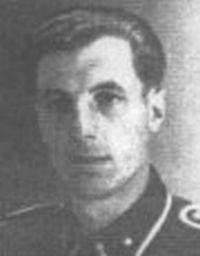 Paul Groth, the man with the dog Source: http://www.deathcamps.org.
Paul Groth, the man with the dog Source: http://www.deathcamps.org.Numbers
During the first period of mass extermination in Sobibor, between early May and late June, 1942, an estimated 90,000 to 100,000 Jews were exterminated. The major part of them, at least 57,000 came from ghettoes and transit camps in the Lublin district, the others predominantly from Czechoslovakia,, Germany and Austria.
As from late July 1942 hardly any transport arrived during two months, due to maintenance work on the railway line between Lublin and Chelm. A few small transports from nearby ghettoes hardly meant a burden for the gassing capacity, on which much work was done during this "quiet" period. As mentioned earlier, in these months the capacity was more than doubled from 600 to 1,300 people per gassing.
From October 1942 onwards, the mass extermination ran at full capacity again. Endless rows of trains arrived in Sobibor, sometimes two or three a day. They transported many tens of thousands of Jews from the General Government and from the west: Austria, Germany, France, Bohemia and Czechoslovakia. The 19 trains from Westerbork must be mentioned in particular, which transported a total of 34,313 Dutch Jews to Sobibor in the period between March and July 1943. A few thousand of them were not gassed immediately after arrival but deployed in and around the camp. Eventually, only 18 of them returned. The last trains arrived in Sobibor in September 1943 from the ghettoes in Vilnjus, Minsk and Lida.
By far the largest part of those who were killed in Sobibor consisted of Jews but Roma (Gypsies) and non-Polish Jews were murdered here as well. The total number of victims is not exactly known. The most recent figures, based on official Polish records, confirm previous estimates and stand at 250,000.
Definitielijst
- Jews
- Middle Eastern people with own religion that lived in Palestine. They distinguished themselves by their strong monotheism and the strict observance of the Law and tradition. During World War 2 the Jewish people were ruthlessly persecuted and annihilated by the German Nazis. . An estimated 6,000,000 Jews were exterminated.
Images
Resistance and uprising
Throughout its entire existence attempts at escape were made and active resistance also took place in Sobibor. For instance, on July 20, 1943 the so-called Waldkommando (forest command) revolted. This group of Arbeitsjuden was to fell trees, collect fire wood and cut branches for the fences. Eight prisoners managed to escape, the rest of the group was shot immediately.
In late summer 1943, rumors circulated in the camp to the effect that it would be closed down. They were kindled by a sharp decrease in the number of transport and messages about the closing down of Belzec whereby all prisoners had been murdered. There was growing fear among the Arbeitsjuden that closing down Sobibor would spell certain death for them. Meanwhile, in the spring of 1943, a small resistance group was established, headed by Polish Leon Feldhendler, who had been chairman of the Jewish Council in the Zolkiev ghetto. Various plans of escape were devised and just as soon discarded again. In that summer of 1943 a mass escape was considered an operation still too risky.
On September 23, on one of the last transports from Minsk, Lieutenant Aleksandr "Sascha" Pecherski arrived, a Jewish officer of the Red Army who had been made prisoner-of-war. Within the shortest time possible, he became the leader of the resistance in the camp with Feldhendler as his right hand man. In secret, Pecherski had the resistance take a short military training and he quickly devised a daring plan for an uprising.
On October 14, Reichleitner, Wagner and Gomerski were away on leave. In particular the absence of the last two was a significant weakening of the garrison of the guards. That opportunity had to be taken. After morning roll call, the revolt erupted. 12 SS men, including second in command SS-Untersturmführer Johann Niemann and eight Ukrainian guards were killed by prisoners with knives and axes and 265 of the some 600 remaining prisoners managed to escape. A number of them soon died however in the minefields surrounding the camp. Some of them were murdered by Poles during their escape. In contrast, some Polish citizens, putting their own lives at stake, have hidden escaped prisoners. Eventually, 47 of them survived the war.
Definitielijst
- ghetto
- Part of a town separated from the outside world to segregate Jewish population. The establishment of ghettos was intended to exclude the Jews from daily life and from the rest of the people. From these ghettos it was also easier to deport the Jews to the concentration and extermination camps. Also known as “Judenviertel” or Jewish quarter.
- Red Army
- Army of the Soviet Union.
- resistance
- Resistance against the enemy. Often also with armed resources.
Images
The end and post-war years
On July 5, 1943, prior to the uprising, Heinrich Himmler had given order to convert Sobibor from an extermination camp to a concentration camp. Right after the uprising of October 14, 1943 he also abandoned the idea of the continuous existence of Sobibor. He ordered evacuation and dismantling of the camp. Lager III was razed to the ground immediately. Late November 1943 the last 30 Jews were killed with a shot in the neck.
The other sections, in particular the buildings near the Rampe remained in use until July 1944 as lodging for the Baudienst.
Summer 1944, the area around Sobibor was liberated by the Red Army. Most of the barracks were still standing and only disappeared in post-war years. Until 1947, the Rampe was used for a different migration. Between 1945 and 1947, the Ukrainian inhabitants of the eastern part of the Lublin district were being resettled in the Ukraine. They assembled in Sobibor and as they sometimes had to wait for transport for days, the wood from the barracks was used for heating.
The tall watchtower in the center of the camp was not torn down because it was being used as an observation point for forest fires after the war. The house of the commander, the Swallow’s nest also remained intact because initially it had been the property of the forestry: the SS simply returned it to them. Moreover, the building had not played a direct role in the extermination process, hence it was not deemed necessary to take it down. The Rampe remained in use until 1960 for loading and unloading goods. The little station building was closed in 1999.
After the war, there was hardly any progress in hunting down the SS men who had been employed in Sobibor and bringing them to court. That was not in the least due to the better known camps such as Auschwitz and the relative large number of survivors of those camps who were still able to tell their story. Few were aware of the existence of Sobibor, very few witnesses were still alive and the perpetrators had started an inconspicuous life as civilians in the meantime.
Franz Stangl managed to escape to Brazil via Syria after the war. He was tracked down by Simon Wiesenthal in 1967 and extradited to the Federal Republic of Germany. In 1970 he was sentenced to life imprisonment for complicity in the murder of 900,000 people. In 1971 he died from a heart attack in the prison of Düsseldorf. In answer to a question, Stangl declared: "My conscience is clean. [..] I just did my job."
Gustav Wagner escaped to Brazil as well after the war. In 1978 he was recognized there by Solomon Szmajzner, a prisoner who had escaped during the uprising. Wagner was arrested but a request for his extradition by Germany was rejected by the Brazilian authorities. He committed suicide in São Paolo in 1980.
Franz Reichleitner, Stangl’s successor was killed in January 1944 in Italy by partisans.
Erich Bauer, the "bath master", was recognized on a street in Berlin by survivor Samuel Lerer. September 1, 1951 he was sentenced to death but his sentence was revised later to life imprisonment. He died in 1980 in the prison of Berlin-Tegel.
The most important trial against the SS men from Sobibor was held in Hagen, West-Germany at the time. It started September 6, 1965 and sentences were passed on December 20, 1966.
Kurt Bolender, former commander of Lager III, worked in a hotel in Hamburg as a doorman under the name Brenner when he was arrested in 1961. He was charged with having personally killed 360 Jews and complicity in the murder of approximately 86,000 Jews. He hanged himself in his cell in December 1965.
Kurt Frenzel worked as a lightning technician in a theatre when he was arrested on March 22, 1962. He was sentenced to life imprisonment for the murder of six Jews and complicity in the murder of 250,000 Jews. He was released on medical grounds after 16 years. He died in a home for the elderly in Garbsen near Hannover, September 2, 1966.
Erich Fuchs, the man who was involved in the construction of the gas chambers, worked as a car salesman after the war. He was sentenced to four years and died in 1984
Alfred Ittner, the "cashier" was sentenced to four years for participation in the murder of an unknown number of persons, but at least 68,000. He died in 1976.
Paul Groth, the man with the dog, disappeared after the war. Nothing has ever been heard of him since. A German judge declared him officially dead in 1951 on request of his wife.
Hermann Michel, the "preacher" was arrested by the Americans shortly after the war but was released in 1946. Since then, nothing has been heard of him.
Erich Lachmann, the commander of the Ukrainians, was acquitted for diminished mental capability. He died in 1972.
Joseph Vallaster, the man of the construction of the narrow gauge railway in the camp, was beaten to death with an axe during the uprising on October 14, 1943.
The Ukrainians went into hiding as well after the war. Only a few were arrested and some even managed to escape to the United States or other western countries. The best known of them was Ivan Demjanjuk, who lived as a retired factory worker in Cleveland, Ohio. In February 1986 he was extradited to Israel but he was acquitted because there was no conclusive evidence he was indeed "Ivan the terrible" who had operated the gas chambers in Sobibor. It has been ascertained though that Demjanjuk had been a guard in Sobibor. After his American citizenship had been revoked, he was extradited to Germany on May 12, 2009 in order to stand trial. He was sentenced to five years imprisonment by a court in Munich on May 12, 2011 for complicity in the murder of at least 28,000 Jews. He appealed his sentence and was released pending his trial. Demjanjuk spent his last days in a home for the elderly in Feilnbach, Bavaria where he died on March 17, 2012.
As late as the 60s, a few dozen Ukrainians have been executed in the Soviet Union.
Definitielijst
- concentration camp
- Closed camp where people are being held captive that are considered to be anti- social, enemies of the state, criminal or unwanted individuals. These groups mostly do not get a fair trial or are condemned to doing time in a camp.
- Jews
- Middle Eastern people with own religion that lived in Palestine. They distinguished themselves by their strong monotheism and the strict observance of the Law and tradition. During World War 2 the Jewish people were ruthlessly persecuted and annihilated by the German Nazis. . An estimated 6,000,000 Jews were exterminated.
- Red Army
- Army of the Soviet Union.
- Soviet Union
- Soviet Russia, alternative name for the USSR.
Images
Information
- Article by:
- Robert Jan Noks
- Translated by:
- Arnold Palthe
- Published on:
- 24-10-2017
- Last edit on:
- 23-10-2021
- Feedback?
- Send it!
Related sights
Related books
Sources
- ARAD, Y., Belzec, Sobibor, Treblinka, Indiana University Press, Bloomington (USA), 1999.
- COHEN, E.A., De negentien treinen naar Sobibor, Elsevier, Amsterdam/Brussel, 1979.
- HILBERG, H., De vernietiging van de Europese Joden, Verbum, Laren, 2008.
- www.auschwitz.nl/woordenlijst/sobibor
- www.auschwitz.dk/sobibor/sobibor.htm
- www.nizkor.org
- stichtingsobibor.nl
- www.sobibor.info
- nl.wikipedia.org
- www.holocaust-info.dk
- www.jewishvirtuallibrary.org
- www.ushmm.org
- history1900s.about.com
- www.verzet.org
- www.deathcamps.org
- www.cympm.com
- www.malingesellschaft.at

